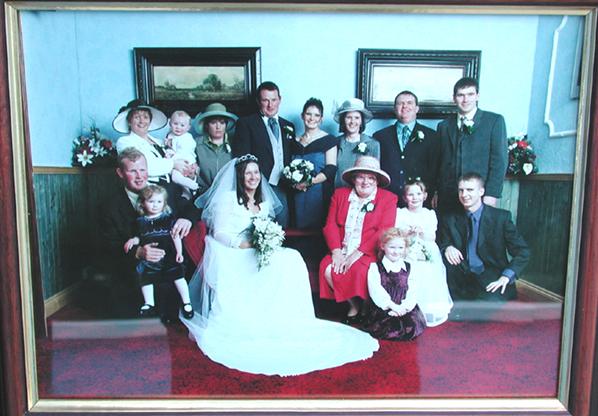The Swantons of County Cork , Ireland
Boston , Massachusetts
and
brooklyn , New york

By Ginni Louise Swanton
The Swantons of County Cork , Ireland
Boston , Massachusetts
and
brooklyn , New york
SECTION ONE
Introduction
On
These photographs sparked in me a curiosity about my roots, and I found
myself asking the age-old question, “Where did I come from?” For some reason, at that time, I was more
interested in learning about the Irish side of my family. When I asked my
parents about our Irish side of the family, however, they had very little
information. All they knew was that the family came from
This wasn’t much to go
on, and I had no idea where or how to begin my research. I discovered the LDS
Family History Centers, and looked up the Swanton surname in their
International Genealogy Index. To my surprise, I found quite a few there, and
just about all the Swantons in
I later learned that
Skull was also known as Schull, and was a pretty little town on the water in

I learned about the
I was still no closer, though, to learning about my Swanton
family. I decided to follow the advice
given to me by many seasoned researchers, and started to work backwards,
finding as much information as possible about my family in
Luckily, I live only
thirty minutes from the Pacific Northwest National Archives. I quickly learned
about Soundex indexing systems, and eagerly delved into the
I learned that civil registration for births, marriages and deaths in
The microfilms finally arrived, and it was very exciting to see copies
of the actual handwritten records from the late 1800’s. There were a number of
Robert Swantons born between 1864-1868, though, and I
still had no idea which one was my Robert Swanton.
My next step was to look through the
Sure enough, one of the Irish civil birth records I had found was for a
Robert Swanton, born in

I didn’t realize at the time how lucky I had actually been. Michael and
Elizabeth (known as Bessie) had had 10 children, and Robert was the only one
who had been born after 1864, which is when civil birth/death and marriage
registration became mandatory. Before then, the only records available were on
the parish level. If he had been born before 1864, I would probably never have
been able to find out exactly where my Swanton family was from in
Well, the rest, as they say, is history. I progressed from an
inexperienced researcher into a dedicated researcher, and in the past four years,
I have amassed an immense amount of information about my Irish Swanton family.
I’ve spent hours sitting in musty archives, poring over microfilms and
thumbing through old dusty tomes. I discovered the Family History Library in
I traveled back to
Two years ago, I went to
I started with the first parish register in Enniskeane, which dated back
to 1813. It was truly an amazing experience to actually handle these books,
very carefully, of course, and to see the original records. The first Swanton
record I found was for 1817. Unfortunately,
it was very hard to read, and the mother’s name was illegible. I found the
baptismal records for nine of Michael and Bessie’s children, as well as many
confirmation and marriage records. I typed every Swanton and Bradfield record I
found into my laptop computer. I also took digital and film photos of these
records. I spent so much time going through the records that Father Sean
McCarthy finally just gave me the key to the church.
As I looked through the church registers, it was easy to lose track of
time. I would stay in the sacristy until about 10 or 11 at night. The later it
got, the louder the creaks and groans of the old building became, and finally
I’d lock everything up and leave. I’d walk outside in the pitch black, past the
cemetery, to Maura Murray’s house. Maura and her husband, Paddy Murray, helped
out at the church, and they were the keepers of the church key.
I spent many wonderful evenings with Maura, sipping tea in front of her
cozy coal fire, and giggling about how creepy the church and the cemetery were
at night.

Maura Murray’s cozy coal fireplace

Maura Murray
In one of
those ironic twists of fate, Paddy Murray told me that his mother had been Anne
Swanton from Lissicorrane. In the course of my research, I later discovered
that Paddy Murray is my third cousin, once removed.

Paddy
Murray, son of Anne Swanton of
Lissicorrane, Cork, Ireland
and “Buttons”
I hired a research firm in
These probate records were the most informative and rewarding records I
have found in my research. Instead of simply providing dates and names, they
provided details of my ancestors’ lives, which truly brought them alive for me.
I’m still uncovering new records, but I decided that at some point, I
needed to organize all the bits and pieces of information I had acquired and to
just sit down and start writing my family history. I hope you enjoy reading it
as much as I have enjoyed researching and writing it.
I’ve organized this book into three sections. The first section is an
introduction. The second section provides information about how the Swantons
ended up in
SECTION TWO
The Swantons: From
England Ireland
My Swantons were either descendents
of the few Swantons who lived in
In 1653, Cromwell formed a new mode
of government called the protectorship. The Catholic officers and nobility were
forced to abandon their estates in the other provinces and cross the
Cromwell, in the meantime, either
wishing to conciliate the Irish by kindness, or give them a favorable opinion
of his benevolence, established at Athlone a court of claims, by which it was
decreed to grant in those parts of the kingdom, to the proscribed proprietors
of lands, (who would be found not to have been implicated in the rebellion,) a
portion of land sufficient for their subsistence, and befitting their qualify
and pretensions. By this regulation it happened that some of these noblemen
enjoyed in
Two of the recipients of these
Connaught Certificates were Michael and Margaret Swanton. Michael is not a
common first name for Swantons, and in the 1800’s, it appeared primarily in the
Catholic Swanton lines in Dunmanway and Midleton. Michael Swanton was the name
of my great great grandfather.
Most of the Swantons, however, arrived in
In The Story of West Carbery, I found the following Swanton reference:
"The Swantons are still another family which must have
arrived in
Smith does not mention it at all,
so apparently it did not exist in 1749 but in Lewis's Dictionary of 1837 we are
told that it had 100 houses and 601 inhabitants, and that a "new line of
road, formed by the Board of Works, from Skibbereen to Rock Island runs through
it".
In 1768 Richard Tonson
demised lands, in and near Ballydehob to William Swanton for lives, renewable
for ever, which suggests the two families were then on very good terms. A
William Swanton made his Will in 1825, and refers therein to property owned or
rented by him in over 70 different townlands, mainly round Ballydehob, but
extending westerly to Goleen, Dunmanus and Durrus, and easterly round
Skibbereen and beyond Leap."
Edward
MacLysaught wrote that “though Swanton is
an English name derived from a place in Norfolk West Cork since the
17th century. There are no less than seventeen references to Swantons in Ireland Connaught
Certificates.[3]
The name occurs frequently in the
“A few Swantons do appear in our records elsewhere; e.g., a sheriff in
From The Book of Irish Families,
Great and Small by Michael C. O'Laughlin
Swanton, of English origins, Swan
“Swanton families are assumed to be of English settler origins. The
family is found in
Several are found in the works of O'Hart, and some are found as 'wild
geese", in the ranks of foreign armies on the continent, as was one James
Swanton of the Irish Brigades in
Several of the name held estates in Cork County Kildare
Swanton Wills Probated in Cork
John Swanton,
Letterbellish, 1717
William Swanton,
Aghill, 1750[5]
George Swanton, 1757
George Swanton,
Banashanaslogh, 1775
John Swanton,
Bandon, 1790
William Swanton,
Gortnegrough, 1798
Robert Swanton,
Ballidehob, 1833
John Clerk Swanton,
Bandon, 1836 (husband of Jane)
James Evans
Swanton, Aghadown, 1837
Young Swanton,
Augaginveen, 1842
James Swanton,
Ballydehob, 1843
Historic
Background
The Williamite War
The Williamite War began in 1689, when the Catholic King
James II of

King William of
After he was deposed, James fled to
In March of 1689, James and his troops landed at Kinsale
in
The war was short and decisive. On
The Treaty of
On
All who submitted under the Treaty of Limerick were to be
allowed to keep their lands if they took an oath of allegiance to King William.
One clause of the treaty seemed to promise that Roman Catholics would be free
to practice their religion. Believing that they had negotiated a treaty that
guaranteed the rights of their people, perhaps as many as twenty thousand Irish
soldiers sailed with Sarsfield to
The majority of the recruits for the Irish Brigade came
from the counties of Claire,
Although the term "Wild Geese" usually refers to
the men of the
James Swanton of the Irish Brigade[6]
Although I have no known connection with this James Swanton, I have included this information to provide additional historical background information about the Swantons of County Cork.
One of these “Wild Geese” was James Swanton. He was born
in
After the outbreak of the Revolution, he, with eighteen
other officers of the old royalist army, was imprisoned at
Promoted to the rank of colonel, he fought through the
Revolutionary and early Napoleonic campaigns, during which he was an intimate
friend of Henry Clarke, Duke of Feltre and War Minister of Napoleon. His great-grand-daughter,
Mrs. Belloc Lowndes, the notable English novelist and sister of Hilaire Belloc,
describes him as a typical officer of the old school: “stern, narrow-minded, very brave and with a high sense of duty.” He died in 1828
in
While still a young lieutenant, Colonel Swanton married
Mademoiselle Chasseriau of
Louise Swanton Hilloc was
interested in English literature and acquired a wide reputation for her French
translations of
Armand Swanton, son of Colonel Swanton, followed his
father’s profession, and he was an officer of the Irish Legion in the French
army from 1804 till 1814. In the latter year, he was taken prisoner at the
French disasters on the Boher during the Napoleonic
campaign in
After the Hundred Days he followed a course of military
studies and, in 1827, was appointed captain in the royal corps of the
headquarters staff. He died at Gap, a little town near Aix in
The Penal Laws
The treaty that Sarsfield had
signed at
As a foreigner from the
As a result of the harsh Penal
Laws, persons of property could not enter into mixed marriages. Catholic
property was inherited equally among the sons, unless one was a Protestant, in
which case he received it all. A Catholic could not inherit property if there
was any Protestant heir. A Catholic could not possess arms or a horse worth
more than £5; Catholics could not hold leases for more than 31 years, and they
could not make a profit greater than a third of their rent. Cases against
Catholics were tried without juries, and bounties were given to informers
against them.
Under
the Penal Laws, Irish Catholics were forbidden to receive an education, enter a
profession, hold public office, engage in trade or commerce, live in a
corporate town of within five miles thereof, own a horse of great value than
five pounds, purchase land, vote, keep any arms for their protection, hold a
life annuity, be a guardian to a child, attend Catholic worship, or educate
their own children themselves.
During the Penal Law days, Protestants and Catholics regarded each other with mutual suspicion and hatred. Secret societies, such as the Whiteboys, were formed by the Catholics. They would go out at night and tear down the enclosures the Protestants erected around the common areas, and would occasionally cut the ear off a tithe collector[7].
Priests and other educated Irishmen who were faithful to the Catholic Church, conducted schools in inaccessible caves or tiny huts, or behind hedges. They were known as “hedge schools”. Seumus MacManus, in his book, “The Story of the Irish Race, describes them as follows:
"Throughout those dark days, the hunted schoolmaster, with price upon his head, was hidden from house to house. And in the summer time, he gathered his little class, hungering and thirsting for knowledge, behind a hedge in remote mountain glen where, while in turn each tattered lad kept watch from the hilltop for the British soldiers, he fed to his eager pupils the forbidden fruit of the tree of knowledge. Latin and Greek were taught to ragged hunted ones under shelter of the hedges whence these teachers were knows as "hedge schoolmasters. A knowledge of Latin was a frequent enough accomplishment among poor Irish mountaineers in the seventeenth century and was spoken by many of them on special occasions. And it is authoritatively boasted that cows were bought and sold in Greek, in mountain market-places of Kerry."
Catholics worshipped secretly at Mass Stones, holy outdoor places where the faithful would gather. Priests were hunted down, mercilessly persecuted, and even hung. These were terrible times for the Irish Catholics.
Most of the Penal Laws were repealed by 1793, but some continued until 1829 when the Catholic Emancipation Act became law.
Swantons: Protestants and Catholics
Although the Swantons who fought
under King William were almost certainly Protestants, over the years, many
Swantons and their descendants became Catholics, probably after the Penal Laws
were repealed. I can’t imagine anyone wanting to convert to Catholicism while
the Penal Laws were still in full effect between 1692 and 1793. Even between 1793 and 1829, the rights of the
Catholics in
My great great
great grandfather, John Swanton, would have been 26
in 1793 when the Penal Laws were just beginning to be repealed. His children,
William, Michael and James all raised their families as Catholics, and at least
one of John’s children was baptized in the Catholic faith in 1817.
The following excerpt from the
book, “Landed Society in
“Rural Protestantism was not the exclusive preserve of the land-owning
ascendancy classes in southern
One such pocket was in the area from Bandon west to Bantry and south to
Skibbereen. Prosperous Protestant tenant farmers inhabited this section of the
county, such as the families of Good, Bradfield, Shorten
(Bandon), Shannon, Dukelow
(Durrus), Sweetman, Trinder
(Clonakilty), Swanton, Attridge, Young
(Ballydehob), Levis, Roycroft
(Schull) Love
(Kilmore), and numerous families of Kingston in Drimoleague.
These families intermarried over generations, maintaining their
Protestantism with some difficulty since they were so economically close to
many Catholic families around them, and producing an intermarriage pattern more
complex than that of the gentry. Such Protestant farming families provided the
raw material in the 1830s when, through the medium of the
When observed from afar, county landed
society in early nineteenth century
After the Penal Laws were repealed in 1829, life was still hard for the
farmers in
The women worked as hard as the men, taking care of their homes and families. They did most of the cooking in bastables--pots that were hung from a crook in the large fireplace. They bore and raised large families, and often had three or four children under the age of six to tend to at any given time. It wasn’t unusual for a woman’s child-bearing years to extend over 20 years.
They cared for the animals, tending to their feeding, milking, egg gathering, and cleaning. They churned the butter and tended the small family gardens. Doing the family laundry must have been a grueling, day-long chore.
Fires were fueled by turf, which was cut from nearby bogs, stacked, dried, turned, and hauled to the home in small turf carts drawn by donkeys. Fields were plowed using teams of horses and crops were planted, harvested, and threshed by hand.
Although the work was hard, there
was a simplicity and joy to their lives. Weddings, births, fairs, and even
deaths were acknowledged and celebrated with music and dancing. There was a
strong sense of community, and families and neighbors looked out for each
other.
Enniskeane/Dunmanway Swantons and Midleton Swantons
Both of these Swanton branches were
Catholic. The Enniskeane Swantons were primarily farmers and carpenters; the
Midleton Swantons were sailors/boatmen. However, I believe that these two
families may have been related.
In the Roman Catholic parish
records for Dunmanway, there’s a record for the marriage of Jeremiah Swanton to
Mary Fehilly on
Jeremiah and Mary’s daughter, Johanna, was baptized in
Midleton in 1866, and Jeremiah’s occupation was given as a boatman. The birth
of their son, Owen in 1870 was registered in the Union of Midleton. Eugene and
Owen are sometimes interchangeable names.
One possibility is that Mary Fehilly Swanton was originally from the
Dunmanway area, and wanted to have her children baptized there. Many of the
Midleton Swantons emigrated to the
SECTION
THREE
The
First Generation of My Swanton Family in Ireland
John Swanton

I believe that my
great-great-great grandfather[8], John Swanton, was born in
In 1852, John Swanton was a farmer and he lived in the townland of Cappeen West in the parish of Kinneigh.[9] He was probably a Catholic, as one of his children (Pat or Cate), was baptized a Catholic in 1817.
I don’t know what his wife’s name was, but based on the naming patterns for his female ancestors, it may have Elizabeth or Anne. I did find the marriage for a John Swanton to a Joanna Crene (Crean) in the Bandon Catholic parish registers. They were married in February of 1804, and their marriage witnesses were James Buckley and Joanne Crene (Crean). The name Johanna or Joanna appears in almost all my early Swanton families, so it’s possible that my ggg-grandmother was Joanna Crene Swanton.
According to local naming
conventions, the first daughter was named after the mother’s mother, although
this convention was not always followed.
John lived a very
long life, especially for those days. According to his civil death record, he
died a widower of old age at the age of 98 on
A Johanna Swanton
who was born in 1771 died at the age of 97 in Coppeen on
John Swanton and
his wife probably had many children, but the only ones I know about are
William, James, and Michael and Pat (or Cate), and possibly John. John was 45
years old when his first known child, William, was born.
There is a reference to a will of a William Swanton in 1750 in Aghill (Aghyohill), which was also in this area, so perhaps John’s father was William. These are both definitely names that have appeared in my Swanton family for generations.
William Swanton was
born in 1812[11],
James Swanton was born in 1813, and Michael Swanton was born in 1815. [12]
Pat (Cate) Swanton was born in 1817. Michael Swanton was my great great grandfather. There may also have been another brother
named John Swanton, named after his father.
Second Generation
Children of John Swanton
Pat (or Cate) Swanton
Pat (or Cate) Swanton was baptized in the Church of the Immaculate
Conception in Enniskeane in 1817. His or her father was John Swanton and the
mother’s name was unreadable. The baptismal sponsors were Brien Riobirth and
Mary Breen. I wasn’t able to find more records about Pat (or Cate).
Second Generation
Children of John Swanton
John Swanton and Ellen Donovan
In February of 1835, John Swanton and Ellen Donovan’s son, Timothy Swanton, was baptized in the Church of the Immaculate Conception in Enniskeane. I have no definite proof that this John Swanton was the son of John Swanton of Coppeen, but the date and location makes this very likely.
Second Generation
Children of John Swanton
William Swanton, Julia Lyons
(Lyne) and their Descendants

William Swanton was
born around 1812[13],
in
Marriage
Record of William Swanton and Julia Lyons


Church of the Immaculate Conception, Enniskeane,
Julia Lyons was born in 1815 in
Ann Swanton was born on
Daniel Swanton was born in 1843, and John
Swanton was born in 1844. I wasn’t able to find their baptismal records.
William Swanton was born on
George Swanton was born in February of 1849.
He was baptized in the Church of the Immaculate Conception in Enniskeane, and
his baptismal sponsors were John Lyons and Mary Donovan.
Sometime after
1850, William and Julia immigrated to the
William Swanton became a
naturalized citizen of the
Ann Swanton, the daughter of William and
Julia, married James Mullen on
James Mullen died on
William and Julia’s son, Daniel, died on
William Swanton
died on

William Swanton’s Grave Stone
Second Generation
James Swanton and Catherine Carty (McCarthy)[15]
James Swanton was born in
James Swanton married Catherine McCarthy (Cate Carty) on
Catherine McCarthy was born in 1814 and died on
James Swanton and Cate Carty Swanton had four children:
Catherine (Cate) Swanton was baptized on
George Swanton, born 1844, married Ellen
Sweeney and Margaret Hurley Dorne
Ellen (Nell) Swanton, born
John Swanton, born 1849, no further information
Johanna (Anna) Swanton was baptized on
Cornelius and Johanna had a daughter, Ellen,
who was born in
William
Michael
James
Mildred
Margaret
Helen
Annie
Madeline
Bridget
Patrick
Edward
Cornelius
Three of these children, Marion, Margaret
and Mildred were still alive as of 2001.
Second
Generation
descendants of James
Swanton and Catherine Regan reily swanton
(Second Marriage for
george)[17]

On
The witnesses to James’ and Cate’s marriage were Margaret Crowley and
Mary Regan. In the parish marriage record, James’ father’s name was recorded as
John Swanton, farmer, deceased, and Kate’s father’s name was Patrick Regan,
farmer, deceased.
Although James was over
60 years old, on
On
HONOUR TO WHOM HONOUR IS DUE
To the Editor of the
Sir -- You would oblige by giving insertion
in your influential Journal to the following good act of an agent, which
sufficiently speaks for itself: -- A tenant of the
Earl of Bandon's, named James Swanton, living in Kinneigh, presented himself on
Saturday last at the office in Bandon. When asked for the half-year's rent,
which was a considerable time overdue, he answered
that he could not pay it. He explained, however, that his inability to pay
arose from domestic troubles, bad harvests and losses in cattle, etc.
What is the reply of Edward Applebe Esq.,
Lord Bandon's agent, to this statement? Does he serve a notice to quit? No --
he pays out of his own pocket 12 pounds 10s, the amount of the half-year's rent
for Swanton, who returns home with a light heart, blessing his benefactor.
What was the surprise and gratitude of that
fabulous character from whose shoulders the hump was removed by the wand of the
fairies, compared with the wonder and thanks of this poor man from whose mind a
real mountain of care was removed by this generous act?
When the kindness of the agent is so great,
what may not this poor man hope for from the munificence of his noble landlord?
- I am your obedient servant,
Signed
OBSERVER
In 1888, James and Kate Regan Swanton, decided
to join their families in
Their passage was paid for by a stepdaughter, Anna Crowley of
James Swanton died at the
age of 75 of bronchitis the day after Christmas, on
Third Generation
Children
of George Swanton and Ellen Sweeney[20]

On
When he and Ellen married, George Swanton was 27 years old and was a bachelor farmer living in Castletown in the parish of Kinneigh. Ellen Sweeney was 24 years old, and was a spinster living in Shanaclough, a townland in the parish of Kinneigh.
After their
marriage, George and Ellen Sweeny Swanton lived in the
Catherine
Swanton
Ellen Swanton,
James
Swanton
William Swanton,
born
John Swanton, born
Johanna
Swanton, born
Hanora
Swanton, born
Catherine
Swanton born
Ellen Swanton born
was confirmed on

Ruins of Coakley Home in Lissicorrane
near the Swanton Home
Photo by Colum
Cronin, copyright 2001
Ellen
Swanton emigrated to
In 1911,
John Swanton (Ellen’s son?) was 18 and worked as a farm servant for Richard
Lynch, a Catholic farmer in the townland of Annaharlick, in the parish of
Kinneigh.
William Swanton (b.
Patrick Sweeney had been
born in
Johanna
Swanton (b.
I haven’t
been able to find any information about James Swanton (born
Ellen Sweeney Swanton died on
Second Generation
Children of George Swanton and Margaret Hurley
Dorne[25]

On
Margaret was born in 1853, and her father
was William Hurley, a farmer. George and Margaret were married in the Roman
Catholic Church of the Immaculate Conception in Enniskeane, and their marriage
witnesses were Daniel Coakley and William Hurley.
Sometime after the birth of their first
child in 1882, and before the birth of their second child in 1886, George and Margaret
Hurley (Dorne) Swanton moved to Lissicorrane.

Ruins of the Swanton Home in Lissicorrane
Photo by
Colum Cronin, copyright 2001
George and Margaret Hurley (Dorne) Swanton
had the following children:
Anne Swanton, born
Mary Anne Swanton, born on
George Swanton, born on December
11, 1887 ,
Lissicorrane
In 1901, Anne Swanton was 18 and worked as a
general domestic servant for the
Mary Kingston was born in 1871. Her maiden
name was Mary Wood, and her father was Richard Wood of Castlelands - just north
of Enniskeane. She married her first cousin and ran the Post Office in
Enniskeane until her death in 1926. Her daughter
In 1911, Annie Swanton was 27, and she worked as a domestic servant for the Nyhan family in Kinneigh. The Nyhan family was Catholic, and consisted of John, 79, a retired farmer, his wife, Anne, 78, their son John, 38, who now ran the farm, and their son, James, 46. The other family members were John’s wife, Mary, and their children, Con, 5, Denis, 4, Mary, 2, and Tom, 1 month.
On
In 1998, Patrick
and Maura Murray lived in the town of
Mary Anne Swanton
immigrated to
According to the Ireland census, in 1901, George was 57 and owned a
farm in Lissicorrane, where he lived with his wife, Margaret, 50, his son
George, 13, a scholar, and his grandson, John, 7, a scholar. There was no
mention of their daughters, Anne and Mary Anne Swanton. George and Margaret
spoke both English and Irish, and could read and write.
[28]
In 1911, George and Margaret
Swanton still lived on the farm in Lissicorrane. George was 69 and Margaret was
61. Their son, George, 22, lived with them, as well as George’s granddaughter,
Jane Good, who was 2.
FIFTH Generation
George Swanton and ELLEN BURKE swanton

George and Ellen Burke Swanton[29]
Photograph
contributed by the Enfield Swantons
George
Swanton was born on
Dennis Swanton, born 1936
George (Seiorse)
Margaret (May)
James (Jim)
Cathleen (Kit)
William (Liam)
John (Sean)
Thomas (Tom)
In 1956, George and Ellen Burke Swanton purchased a farm (plot #4) in the townland of Moneygaff East, Coppeen in the parish of Kinneigh from Jack Brennan. In 1969, the Swantons also took over the Sullivan’s farm (plot #5). Moneygaff is also referred to as Moneygove and Munigave.
George
Swanton, the husband of Ellen Burke Swanton died, a widower, on
His
wife, Ellen Burke Swanton died on
FIFTH
GENERATION
DESCENDANTS
OF GEORGE AND ELLEN BURKE SWANTON

The
oldest son of George and Ellen Burke Swanton, Denis Swanton, died on
Their second son, George (Seoirse) Swanton, married Mary Murray and they had six children.

In
1998 George and
Mary Murray Swanton still lived in Coppeen. George (Seiorse) Swanton died on

During
a trip to

Swanton
Home in Moneygaff East, Coppeen
Geraldine
and Mary Murray Swanton (Seoirse’s wife)
Photo by Ginni Swanton, 2001

Geraldine
Swanton and her mother, Mary Murray Swanton
at home in Munigave,
Coppeen
I
also had an opportunity to meet Tom Swanton, the brother of George (Seiorse)
Swanton. Tom lives in a trailer on the Swanton land in Munigave. We had a
lovely visit, and Tom serenaded me with many original songs. He is quite a
delightful character! I recently learned that Tom has been to the

Tom
Swanton of Munigave

Tom
Swanton and his trailer at Munigove
I also visited with Tom’s brother, Jim, who now lives in Castletown, and we had a nice chat over a couple of pints of stout at the Castletown pub with Colum Cronin, a local songwriter and singer with whom I’d been exchanging e-mail. Jim was born in 1929.

Jim
Swanton of Castletown
During my visit, I met many more of the Swanton family. We all got together one evening in Clonakilty and we had a great time sharing photos and getting to know one another. Everyone was very hospitable and welcoming, and seemed very interested in the research I had done.
The Coppeen Swantons believed that our Swantons were originally from Ballydehob, and had been there during the 1798 uprisings. There was some comment about them having been “great fighters”, the implication of which was that they were really just great talkers. According to family stories, the Swantons then lived in Ballinascarthy (hometown of Henry Ford) before moving north to the Enniskeane/Coppeen area.

Eileen
Swanton Brennan, Mary and Geraldine Swanton
and Paddy

Richard
Bradfield, Margaret Swanton O’Sullivan, Eileen Swanton Brennan
and Mary Murray
Swanton
Margaret
Swanton O’Sullivan’s Wedding Photo

William
(Liam) Swanton currently lives in Skibbereen. He spend
most of his career as a pig trader. His daughter, Geraldine,
and her husband, Cillian Ryan live in
John
(Sean) Swanton and his wife, Eileen Driscoll live in


Dennis Swanton’s Obituary,

Clare
Swanton and Eileen Driscoll Swanton of

Sean
(John) Swanton of

Swanton girl from

Eileen
Driscoll Swanton of

Susan Swanton of
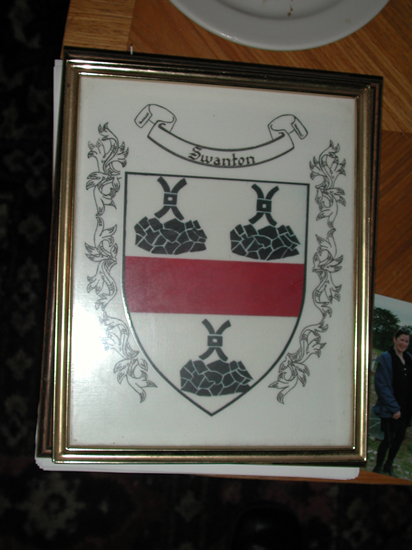
Swanton
Coat of Arms from
Fourth
Generation
Children of James Swanton and
Catherine Carty
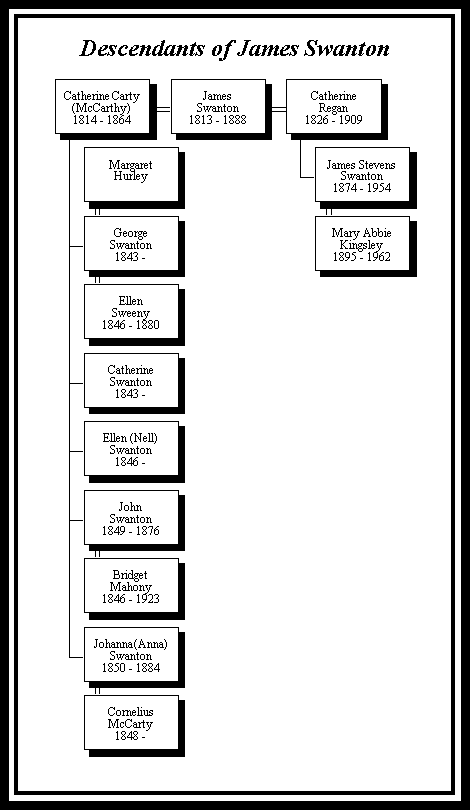
ellen swanton and john hurley
Ellen (Nell), the
daughter of James Swanton and Cate Carty Swanton, immigrated to
On
Fourth Generation
Children of James Swanton and Catherine
Carty
Catherine Swanton
Catherine Swanton may
have been the next of James’ and Catherine’s children to leave
johanna swanton and cornelius McCarty
Johanna[34]
Swanton arrived in
On
Cornelius McCarthy became
a naturalized citizen of the
James’ and Catherine
Carty Swanton’s son, John Swanton, immigrated to Boston, arriving either on May
3, 1871 at the age of 23 on the S. S. Samaria, or on April 15, 1868 at the age
of 22 on the S. S. Tripoli.
john swanton and bridget mahony hurley and Descendants
On
John and Bridget were married at
the
Bridget and John Swanton’s first
child was born on
Bridget and John’s second child was
also a girl. She was born on
1876 was a very difficult year for
this Swanton family. In April 1876, John Swanton developed cancer of the thigh.
He suffered from this condition for four months, and died on
Just two weeks after John’s death, on
By 1886, Bridget had become a naturalized citizen of the
After John died, his widow, Bridget Swanton, supported herself and her
daughter, Ellen, by running a boarding house. In 1900, Bridget lived at
In 1900, the other boarders living at Bridget Swanton’s boarding house at
Emma Ryan, single, age 14, born April 1886 in
John Johnson, single, age 28,
born May 1872 in Sweden of Swedish parents. He had immigrated to the
Oscar Johnson, single, age 23,
born January 1877 in Sweden of Swedish parents. He was probably John’s
brother. He immigrated to the
Mary Gardener, widowed, age 70, born March 1830 in
Ireland of Irish parents. She had never had any children. Mary immigrated to
the
Daniel Lorden, single, age 48,
born December 1852 in Ireland of Irish parents. He immigrated to the
As the keeper of a boarding house, Bridget would have tended to the house, making sure that the rooms were clean and tidy, and cooked and served the meals. She may have also laundered her boarders’ clothing—for an additional charge, of course.
Modern conveniences such as vacuum cleaners, dishwashers, and washing machines had yet to be invented, and taking care of a home in 1900 was a tedious and time-consuming proposition.[44]
Bridget was probably also a surrogate mother to young Emma Ryan, John and Oscar Johnson, and a confidante and friend to Mary Gardener and Daniel Lorden.
In 1910, Bridget and Ellen Swanton lived at
In 1910, there were only two lodgers living with Bridget and Ellen. They were:
Dennis Hayes, single, age 42, born in Massachusetts of Irish parents. He worked as a cooper in a sugar refinery.
John Waterhouse, single, 58, born in England of English parents. He worked as a baker in a bakery.
In 1920, Bridget and Ellen Swanton still rented their home at
Bridget Mahoney Hurley Swanton died in 1923 and was buried in
Fourth Generation
Children of James Swanton and Kate Regan
James Stephens Swanton and Mary Abbie Kingsley and Descendants
In 1920, , James Stephens Swanton, the son of James and Kate Regan Swanton, was living with his sisters[47], Annie and Margaret Crowley in a two-story house at 54 Allerton Street in Plymouth, MA. James was working as a carpenter, doing general work.[48]
On
On
James Stephens Swanton Sr. died on
The following obituary appeared in the Boston Globe on
“Jas. S. Swanton of
He was a son of the late James and
Kate (Regan) Swanton. For 50 years he was engaged in the real estate and
contracting business and was an appraiser for the
Surviving him are his widow, Mrs. Mary
(Kingsley) Swanton, a daughter, Miss Catherine Swanton, and a son, James S.
Swanton Jr. The funeral will be Friday morning at 8 o’clock from the funeral
home, 150 Court Street, followed by a solemn high mass of requiem in St.
Peter’s church at 9 o’clock. Interment will be in
Mary Abbie Kingsley Swanton died in 1962 at the age of 67.
James’ and Kate’s daughter, Catherine, married a man named Brock.
Second
Generation
Michael Swanton and
Elizabeth (Bessie) Bradfield

Michael Swanton and Elizabeth (Bessie) Bradfield Swanton were my great great grandparents. They were married on
Bessie’s father, Michael Bradfield was born in 1786. He was a farmer and
my great great great
grandfather. Michael Bradfield died on

Bradfield House in Killowen

Kitchen of Bradfield House
Maura, Michael and Tommy Bradfield
There is a family cemetery on the Bradfield farm, but the stones have
been worn smooth by time, and no writing is discernible on them. This may be
where Michael and Martha Bradfield are buried. There is also a Bradfield family
plot in the old Murragh cemetery.

This stone was erected and this ground
registered by Thomas Bradfield in memory of his father James Bradfield who
departed this life July 6th, 1809, aged 46 years.
The James Bradfield for
whom this stone was erected was born in 1763, and he may have been Michael
Bradfield’s father and my gggg-grandfather.
In 1852, Michael Swanton lived in Derrigra, which was part of the town
of
According to legend,
poteen has been produced in
Boulteen is a small townland of 212 acres[51],
and was located next to the manor house of
In 1864, the occupants of the townland of Boulteen were:
1a.
Joseph Moore, who rented a house, shop, and 54 acres, 9 perches, from Dr. John
Beamish.
2a.
Thomas Buttimer, who rented a house, shop, and 74 acres, 1 rood, and 7 perches
from Dr. John Beamish.
3ab. Thomas Baldwin, who rented a house, shop, and 84 acres, 17 perches, from Dr. John Beamish.
3c. Michael Swanton, who rented a house,
office, and pound on 20 perches from Thomas Baldwin, valued at 1 pound.
In the 1800’s, a fair used to be held at the Boulteen Cross Roads every
year in June. I visited the Boulteen Cross Roads in 1998, and again in 2001.
They were simply two intersecting grass roads with swinging iron fences on the
road to Bandon and points west. No houses remained, although I found some stone
ruins that appeared to be from old houses.

Remains of a house at Boulteen Cross Roads

Old
Although the tenants changed quite a bit
from 1867-1870, Michael Swanton continued to rent the same property. He rented first from Thomas Baldwin, then
from Thomas Bennett, and later from Mary Moore, a descendant of the Joseph
Moore who had rented the property at 1a in 1864.
In 2001, the site of the pound that Michael Swanton rented was covered
with a tangle of vegetation. The owner of the land in 2001 (Tim) told me that
it is said that many people died there during the famine, and that he is never
going to clear that area.
On
Over a 21-year period, Michael and Bessie had ten children:
John Swanton, b. 1843 d. 1913
Anne Mary Swanton, b. 1847
Michael Swanton, b.1849 d. 1922
Johanna Swanton, b. 1851
Ellen Swanton, b. 1854 d. 1932
William Swanton, b. 1856 d. 1921
Martha Swanton b. 1857 d. 1927
George Swanton b. 1859
James Swanton, b. 1862 d. 1901
Robert A. Swanton, b. 1865, d. 1933 (my
g-grandfather)
Parish baptismal records don’t include the name of the townland where
the family lived. Robert was Michael and Bessie’s tenth and last child,, and the only one who was born after 1864, which is when
civil registration became mandatory. His civil birth record confirms that the
family was living in Boulteen at the time of his birth (April 24, 1865).
Michael and Bessie and their family survived the potato famine of
1845-1847, although it appears that they didn’t have any children in 1845 or
1846.
In August of 1880, Michael, Bessie, and their sons James and Robert,
left
I wondered why Michael and
Bessie decided to emigrate after they had spent most of their lives in
A group of men from the Castletown
area traveled to Bandon to tell the Guardians of the Bandon Union about their
plight.
“The relieving officer went outside
the door and was accosted by about twenty five men, fine specimens of the Irish
peasantry, but many of them bearing on their countenances the impress of
hunger. They were men of ages varying from eighteen to sixty, and had traveled
from Castletown to Bandon, a distance of ten miles, breakfastless. Three men
were selected to lay their grievances before the guardians -- an old man,
nearly sixty years of age, and two middle-aged men.
Spokesman: We are very destitute
and don't know what to do. All we came here for is to try to live in the land
as long as God Almighty will leave us. We don't want to beg a farthing as long
as we are able to work. It's only right to give a man fair play. If you don't
give us work, let us be put into gaol[54],
or let us die.”
“The inhabitants of
Castletown Kinneigh and the surrounding districts crept on Tuesday, the 20th
inst., as half-starved and emaciated beings, to assist at a meeting, held at
Castletown village having for its object the proposing of some resolutions, or
instructing some means to alleviate their present more direful distress.
Half-starved they rose, and cast aside their inactivity at last, hunger
pinching them, and pronounced emphatically (of which I am an every-day
witness), that starvation was knocking unmercifully at their cabin doors.”
MEETING AT ENNISKEANE
After the
The Rev. Michael Delay, the respected P.P. was moved to the chair, and
Mr. O’Driscoll was requested to act as secretary to the meeting.
The Rev. Chairman, in his usual lucid and impressive manner, explained
the object of the meeting, and in the course of his remarks, said that he felt
heartfelt sorrow that such an amount of distress existed in his parish. He
waited on J. R. Berwick, Esq., J.P., the feeling and popular agent to his Grace
the Duke of Devonshire, and also on Mr. Doherty, J.P., agent to the Earl of
Bandon, asking them to devise some means to keep the people from starving, and
he was happy to tell them that both gentlemen received him in the kindest
manner, and promised to provide employment forthwith for the labourers on the
respective estates which they represented.
The Earl of Bandon had some labourers employed in the northern part of
the parish, and will employ others in some other parts of the parish
immediately. So much alive to the present and state of the locality is Mr.
Berwick, that he authorized him to say that every farmer on the estate of his
Grace of Devonshire, in the parish, may instantly employ labourers for
draining, &c., and his Grace will allow them for it.
Mr. Berwick will also employ a number of labourers
to-morrow clipping off the trees in the plantations near Enniskeane, in order
to provide for present very pressing cases. The Rev. Chairman further said that
Mr. Conner, J.P., of Manch, a gentleman who had a long and varied experience as
guardian, chairman of dispensary committees, &c., told him that he knew the
people to be actually starving. He, Mr. Conner, had a considerable number of
men employed at a distant portion of his property, and hoped, in a very short
time, to be able to employ several others at Manch. But, said the Rev.
Chairman, there is a class of labourers who have my fullest sympathy—those who
are engaged to work for farmers during the whole year, at 4d. or 6d. per day, the rent of their
little cabins, and potato-ground. I will not harrow your feelings by reminding
you of what the latter was worth, especially last year.
He impressed on them the necessity of patience and trust in God, and He,
in His goodness would not neglect them, and the landlords would do all they
could to employ labour, as Lady Carbery is doing at Phale.
VOICES: Long live your reverence.
Mr. Patrick Harrington, P. L. G.[57],
Kinneigh, proposed, and Mr. Patrick Foley, seconded the following
Resolution:--“Resolved—That it is our painful duty to record that very severe
destitution prevails in this parish, and that unless immediate and effective
steps be taken to remedy same, starvation will be the deplorable consequence.”
Mr. Harrington said that to his own knowledge parties in that locality
were obliged to subsist on one meal of stirabout in the day, and that he saw
men before him who had not the price of a half-penny bun for themselves and
family. He would beg to impress on those who could afford it to keep his
countrymen from starving.
The resolution was passed unanimously.
Mr. Denis Mahony, Clonomara, proposed, and Mr. C. O’Sullivan, seconded:
--“That the following be, and are hereby appointed a Local Relief Committee --
“The clergymen of all denominations, the dispensary doctors, the P.L.G’s of the
locality, the members of the Dispensary Committees, and the following
gentlemen: -- Messrs. D. Connor, Jun., Manch; John Carey, and Thomas Kearney,
Currycrowley; B. Scofield, Knockaneady; P. Lordan, Liscroneen; Denis Crowley,
Ahillnane; Wm. Daunt, Enniskeane; James Chambers, Teadies; P. Harrington, P.
Foley, Kenneigh; Joseph Fuller, Castletown; James Welply, Denis Mahony, Clonomara;
Dan Crowley, Lissecorrane; Dan Crowley, Ardkilleen; Dan Hurley, Clonereague;
Lawrence Buckley, Moneygoff; P. Donovan, Derryville; J. Flynn, Tullimurrihi;
David Walsh, Ahiohill; E. White, Garavauler, with power to add to their
number.”
The want of fuel is also much felt, as several poor families have no
fuel, except the hulls of flax, which the proprietor of the local scutching
mill (James Hutchinson Swanton of Ballydehob) is kind enough to give them. The
Rev. Chairman relieved some of the most urgent cases out of his own private
purse.
After a vote of thanks to the Chairman the meeting separated.
TO THE EDITOR OF THE
SIR,--I send you a copy of a letter addressed by me to the Land League,
which you will kindly publish in your next edition, and thus help us in our
present difficulties. Yours very truly,
T.
Drimoleague,
DEAR SIR, -- On behalf of my poor parishioners I beg to appeal to your
association for aid to enable us to keep our poor farmers in their holdings and
the poor labourers from starving. This is not exaggerated language, but the
real truth. I have in this parish at present, over twenty farmers ejected from
their holdings during the past year, and now in actual want of food for
themselves and children.
On one townland alone the landlord has ejected four tenants during the
past year, some of them as yet keeping possession till the Sheriff’s officers
came and thew them on the roadside, or rather hillside, as there is no road in the
locality.
This very morning the wife of one of these victims of landlordism was
with me for advice about what to do. She had struggled with the perseverance of
the Irish farmer to retain her land, and by appealing to friends and the
charitable made up a year’s rent and took it to the landlord, but she was
spurned from his presence and told that she should pay ten pounds besides for
costs, and thus that poor creature who, a few years ago was a strong and
handsome woman, appears today a heap of rags and the very personification of
wretchedness.
This is no isolated case. There is on the same property a worse case if
possible. He has eleven in family, and but himself to provide for them; even
last year when ejected he would not get his manured field for potatoes. The
ejected farmer makes but a bad daily labourer, his spirits are crushed, and he
has no heart to push his claims forward, but prefers to hide his privations,
and thus it is not easy often to reach such cases till extreme distress compels
him to disclose his wants. And if this be the case with our farmers, need I say
that our labouring population must be wretched in the extreme.
In my entire parish there is not a single landlord giving work to a
labourer, nor have they come forward to subscribe to our fund for relieving the
distress in our district, although they are receiving thousands of pounds
annually.
What has become of the saying that “property has its duties?” I shall
not add anything else, but that your aid shall be given to objects most worthy
of it, and distributed as you shall order. We have in this parish already
committees for distributing the aid obtained from the other public funds in
your city, and if you should wish to avail of this mode, I will be happy to
comply with your wishes, otherwise, it shall be effected as you shall order,
and to the class of persons you wish. You will be pleased to lay this appeal
before the Land League, and ask for a favourable consideration for it, and
believe me, yours very faithfully,
T.
“One hundred and thirty-five families got relief. The number of
destitute applicants is so much on the increase that, unless subscriptions from
the landlords and other sources come soon and liberal, the consequences will be
deplorable.”
In light of the desperate
conditions that existed in the Castletown-Kinneigh and surrounding areas in
1880, it isn’t surprising that Michael and Bessie Swanton decided to leave

Bandon Bridge near Enniskeane
It was very common in
those times for Irish immigrants to join family members who had already
emigrated and who were settled in their new homes. Michael and Bessie’s son,
John Swanton and his wife, Mary McCarthy Swanton, had immigrated to
Making the decision to leave their homeland of more than 60 years probably wasn’t easy for Michael and Bessie, in spite of the hardships they had endured there. They were leaving behind a lifetime of friends, memories, and a way of life that their families had followed for generations.
Nevertheless, Michael and Bessie sold their household furnishings, packed up their meager possessions, and in August of 1880, they departed from the port of Cobh[61], County Cork, on the S. S. Samaria with their sons James, age 18 and Robert, age 15, bound for Liverpool and eventually Boston, where they arrived on August 15.

Passenger list for the S. S. Samaria,
listing the names of
Michael, Elizabeth, James and Robert
Swanton
Arrived in
The S. S. Samaria was
built in 1868 by J. & G. Thomson, Ltd.,

S. S. Samaria
Although Michael was 65
and Bessie when 60 when they emigrated to Boston, both of their ages were
recorded as 50 on the Samaria’s passenger list, and James’ and Robert’s ages
were recorded as 15 and 13, although they were actually 18 and 15. There is
quite a bit of disparity in the ages my Irish ancestors provided for various
records. It’s possible that they didn’t remember exactly when they were born,
or they simply didn’t care. Another theory is that they might have represented
themselves as younger on the passenger list in order to ensure passage. A
50-year old man would have been perceived as more able to find a job in the
Although the Irish had
been immigrating to
The Irish were regarded as drunkards and brawlers, and were not welcomed by the locals, who hung “Irish Need Not Apply” signs in their store windows. Taverns sprang up on every street corner, and they provided a place for the Irish men to get together and enjoy the company of their fellow countrymen.
Often, Irish families were supported by their women, who hired themselves out as domestics, while the men tried to find day labor.
By 1880, the flood of
immigration into
Although by 1880,
attitudes in
The following excerpt
from the book “
“All the heavy
trucking of freight throughout the city was still done on huge four-wheeled
wagons called drays, about the size of a modern ten-ton truck and drawn by two,
four or sometimes even six great horses, which were kept stabled in South
Boston. Every morning at
Once the children were
in school, the streets filled with the sounds of peddlers, each with his own
distinctive cry, calling out their wares and rousing the housewives of the
neighborhood. The vegetable man yelling “fresh tomatoes!” made his way through
the streets with fresh vegetables for the kitchen table. The fish man bawling
“haddock and mack-er-ellll!” was a popular figure on
Thursdays and Fridays, although his wagon usually attracted every cat on the
street because he butchered the fish as he sold them. The rag man, with his
broken-down wagon and worn-out nag, rattled along shouting, “Any rags, any
bones, any bottles today?”
The scissors-grinder,
with his complicated contraption of wheels, levels, foot-pedals, pulleys and
bells, was always a fascinating sight. The soap-grease man sliced off a bar of
very heavy, dark-brown laundry soap and gave it to the housewife who handed
over her used fats and grease. The piccalilli man went around with two or three
different kinds of relish on his cart, lading it out for a modest price.
Frequently, the tinkling sounds of “O Sole Mio” of “Funiculi
Funicula” brought people into the streets. Sometimes
it was the organ-grinder, balancing his portable organ on its single wooden
leg; sometimes it was the hurdy-gurdy man, pushing his large upright organ
along on two wheels. But almost always it was the antics of the monkey that
captured the attention as he went through the crowd at the end of a long chain
collecting pennies and nickels in his little red cap.
On hot summer days,
the watering cart sprinkled water on the broiling streets; and in days before
refrigeration, the ice man was always in great demand as he lugged huge cakes
of ice on his back up two or three flights of stairs to the icebox in the
kitchen. “

Michael, Bessie, Robert
and James arrived in
Michael, Bessie, Robert
and James would have been greeted at the dock by John, Mary, and their
children. Their first night in
This was the also first
time that Michael and Bessie met their three granddaughters, who had all been
born in
Michael and Bessie moved
in with John, Mary, and their five children. They lived at 306 West Second
Street in
In 1882, three more of
Michael and Bessie’s children immigrated to
Sometime before 1883, John Swanton, his family, and his parents and brothers, moved down the street to 274 West Second, which presumably had more room to accommodate them all. [63] Ellen Swanton and Martha Swanton may have moved into the house at 306 West Second then, as Ellen, her husband and their children still lived there in 1898.
In 1883 and 1884, Bessie and Michael celebrated the marriages of three of their children. On February 6, 1883, Martha Swanton was married to Michael Crowley; September 30, 1884 Ellen Swanton was married to Michael Cleary, and on October 5, 1884, William Swanton was married to Anne O’Neill.
Bessie Bradfield Swanton
died on

Bessie died just one month before Ellen Swanton Cleary’s first child, Margaret Cleary, was born, and two months before her son James Swanton married Ellen Ahearn.
Five months later, her
granddaughter, little Margaret Cleary died, and she was buried with her
grandmother in
In 1921, Annie Swanton, the wife of William Swanton, Bessie’s son, was buried in the same grave as Elizabeth Bradfield Swanton. William had a stone engraved with the names of his mother and his wife. Although Bessie had died in 1885, the year 1884 was erroneously carved on her gravestone.

After Bessie’s death,
Michael had no reason to remain in
When Michael and Bessie
had left
I haven’t been able to find
any more information about Michael and Bessie’s other children, Anne, George
and Johanna. They may have remained in
Michael Swanton Sr. had
been plagued with health problems since 1880, suffering from stricture of the
urethra. On
The workhouses had been
Masters Report of the
I beg to report that on

Finding this information made me feel a lot better. Now I knew that Michael had not been abandoned and forgotten by his family. It was probably Michael’s son, William, who had sent the money, as he was the only one in the family who had any. This also let me know that Michael had some friends in the workhouse, although they seem to have been far too interested in acquiring the money William had sent for Michael’s care.
A couple of questions remain: did Father Murphy use the remaining money to give Michael Swanton a proper Catholic Mass and burial, and if so, where was Michael buried? Perhaps someday I’ll be able to learn the answers to these questions.
Third Generation
Children of Michael Swanton and Elizabeth Bradfield
John Joseph Swanton and
Mary Theresa McCarthy
John Joseph Swanton was born on
When John was born, the Swanton family may have lived in a section of
the town of
On
In 1870, John was working as a carpenter in Ballineen. On
John and Mary’s second child was born on
On
John Swanton was not in
John and Mary must have had a happy reunion when he met her at the dock,
and he got to see his new little son, James, for the first time. After
traveling overseas with two small children for two weeks, I can imagine that
Mary was delighted to let John take care of them for a bit!
John and Mary Swanton
lived at 335 West Second Street,
The Swantons moved to a
two-family house at 306 West Second Street, where their second daughter,
Catherine, was born on
The Swantons shared the
house at 306 West Second Street with John McDonald, a
carpenter from
John and Mary Swanton’s family continued to grow. On
On August 15, 1880, John’s parents, Michael and Elizabeth Swanton, came
over from Ireland with their sons Robert and James, and moved in with John and
Mary at their home on 306 West Second Street in South Boston. Mary must have
welcomed
On
On
On
Sometime before 1883, John Swanton, his family, and his parents and brothers, moved down the street to 274 West Second, which presumably had more room to accommodate them all. [72] Ellen Swanton and Martha Swanton may have moved into the house at 306 West Second then, as Ellen, her husband and their children still lived there in 1898.
On
John’s mother, Bessie
Bradfield Swanton, died on
The following announcement of Bessie’s death appeared in the Boston Globe:
SWANTON: -- In this city, 28th inst., Elizabeth, beloved wife
of Michael Swanton. (Funeral Tuesday from her late residence,
After Bessie’s death,
John’s father, Michael Swanton, returned to
On
John’s naturalization oath read:
“I, John Swanton, do solemnly swear, that I do absolutely and entirely
renounce and abjure all allegiance and fidelity to every Foreign Prince,
Potentate, State or Sovereignty whatsoever,
-- particularly to Victoria, Queen of the United Kingdom of Great Britain
and Ireland, whose subject I have heretofore been; and that I will support the
Constitution of the United States of America – so help me God.”
John’s wife and children automatically became naturalized citizens when John was naturalized.
In 1890, John and Mary
Swanton lived briefly at
From 1891 to 1895, their
son, John Joseph Swanton Jr., lived with his family at
Fourth and Fifth Generations
Descendants of John Joseph Swanton
and Mary Theresa McCarthy

On
On
Since
Elizabeth Swanton’s
marriage to John Boyd didn’t work out and they were divorced a short time after
their marriage. Divorce was very uncommon in those days, especially in Catholic
families. On
Just a month after
Elizabeth Swanton married John Boyd, her sister, Catherine, aged 21, married
Patrick J. Finan. Catherine and Patrick were married on Valentine’s Day of 1898
at the Catholic Cathedral of the Holy Cross in
There is an odd aspect to their marriage, as well. The civil record for Catherine and Patrick’s marriage lists Catherine’s parents as Thomas J. Swanton and Ellen E. Gleason, and this doesn’t appear to be correct.[75] I don’t know why Catherine would have provided incorrect information about her parents. Perhaps she was trying to keep the marriage a secret from her parents. There were a couple of other anomalies -- young girls of this era usually lived at home until they were married, and Catherine lived away from home at age 21. She was also married in a church that was outside of her regular parish. Usually girls were married in their home parish.
Catherine and Patrick
Finan had three children[76]:
Mary E., Dorothy K., and Arthur P. Finan. Mary’s married name was Brennan and
in 1927, she lived at
Catherine and Patrick
were married for 29 years, until Patrick’s death in 1927. When Patrick died, he
was a roundsman[77],
and lived at
Mary Ellen (sometimes
referred to as Mary Helen or Helen Mary), was the next Swanton girl to marry.
On
By 1900, the only
children still living at home with John and Mary Swanton were Johanna and
Daniel. John Joseph was living at
From 1905 to 1910, Daniel Swanton lived at home and worked as a baker. He died in 1913 at the age of 30.
John Joseph Swanton Sr.
died on
In 1914, Johanna Swanton,
who was 29 and still living at home with her mother, married Frederick G.
Henderson. They were married by Father William Comer, a Catholic priest, in
John’s widow, Mary
McCarthy Swanton, died on
Third Generation
Children of Michael Swanton and Elizabeth Bradfield
Anne Mary Swanton
Anne Swanton was baptized on
Anne Mary Swanton was confirmed on
I haven’t been able
to find any further information about Anne Swanton, the daughter of Michael and
Bessie. On
However, on the
civil marriage record, Anne’s father’s name was given as James Swanton. The
marriage witnesses were George Swanton and James Swanton. Thomas Gallivan’s
father was Edward Gallivan. The parish record for this marriage did not give
the name of Anne’s father.
I did not find a
baptismal record for an Anne Swanton, born to a James Swanton in the Enniskeane
Roman Catholic records, so perhaps the father’s name on the civil marriage
record is incorrect. There were no confirmation records for any other Anne
Swantons.
Third Generation
Children of Michael Swanton and Elizabeth Bradfield
Michael Swanton and Jane
McCarthy
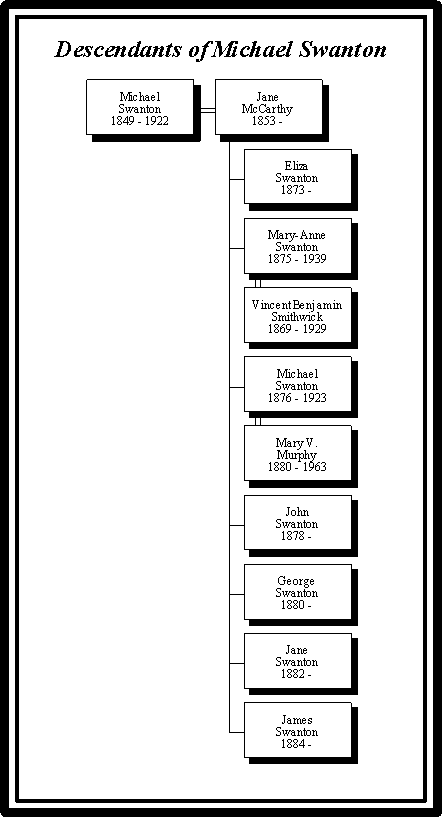
Michael Swanton, and son of Michael Swanton and Bessie Bradfield
Swanton, was baptized in the Church of the Immaculate Conception in Enniskeane[79]
on

Michael was confirmed on

On

In 1873, Michael and Jane Swanton lived in Clancool, just outside of
Bandon, where their first child was born on
On
Usually the firstborn boy was named after the father’s father, or
occasionally after the mother’s father. I had thought that Michael and Jane had
broken from this tradition until I received mail from their great grandson,
Edward Terence Swanton in 2001. He was descended from Michael and Jane’s oldest
son, Michael. I hadn’t found a birth record for Michael, and my correspondence
with Edward opened up a whole new family line I hadn’t been aware of
previously. Michael Swanton was born on
On
Michael and Jane McCarthy Swanton moved to Boulteen, most likely into
the house that Michael’s parents had been renting there, and on
On
On
Michael Swanton may have left
Michael Swanton, the son of Michael and Elizabeth Bradfield Swanton,
died in the


Michael and Jane’s daughter, Mary Ann Swanton, immigrated to
Mary Ann Swanton Smithwick died on
Ginni...My father was Marinus Smithwick, son of Benjamin and Mary. His Aunt
Gen took care of his Uncle
Jim's son William, or as we called him, Willie.
I
am just beginning my ancestry
search and I have some records from the two
ships that Benjamin's father
served on in the Civil War. I named my
son,
Benjamin after his greatgrandfather. Ann
Smithwick Ferro
I have information from the
ships manifest that Thomas was born in
and was 6 ' 1' tall with brown
eyes. He joined the US Navy in NYC He was 22
in 1863.
This is the information that
I have from my Aunt Lucy...Benjamin's and Mary's
daughter:
Ann Collins married Jeremiah
McCarthy. Their first child was taken by
Jeremiah's
parents to
Jane who
married Jeremiah Swanton.
They had seven
children:
Lizzie
(Galvin)*,
Mary,
Mike,
George,
John,
Gen(Moger) and
James.
One of the
descendants of the Galvins
lives in
married Jim McDowell and their son
and his family live in Caz.
Marian died
over 15 years ago but I had the
privilege of getting to know her well.
She
spent a part of her childhood
living with Lucille (Aunt Lucy) Smithwick
Caffrey. Aunt Gen was a truly remarkable woman who
lived across the driveway
from our Aunt Mina (Philomena
Smithwick Lowery)
She had a dog named
Flashy,
a snowglobe
which I lusted after and always a pot of tea and Dugans
coffeecake for visitors. I have a tiny
dresser that she gave me when I was in
college. Uncle Jim lived up the street on
always wore tweed suits and smoked
a cigar. We didn't see him very
much. I
never met Uncle George, Uncle
John or Uncle Mike. My Aunt Mina took me
to
the graduation of Lizzie Galvins grandsons in
years old.
I remember Willie Swanton as
one of the most handsome men my young mind had
experienced. He was a big tease when I was a child. He thought of his Aunt
Gen as his mother. I can only vaguely remember his beautiful
wife and his
daughter Carolyn or Carol ann. I am sorry about this name because there are
several variations of this name in
the Smithwick line. I know that Willie
was cursed with diabetes and
suffered loss of vision quite young. He
escaped
another Swanton genetic
inheritance...allergies and asthma..which
claimed two
lives in Aunt Lucy's son James
and Uncle Chris's daughter Carol Ann.
I hope that you are
receiving my mail. There are two others
in the family
who are very interested in geneaology and would welcome a collaboration. One
is Carol Ann's daughter, Lynn Urban and the other is the granddaughter
of
Marinus Smithwick (my Dad), my
sister Joan's daughter,
Kathe-Ann
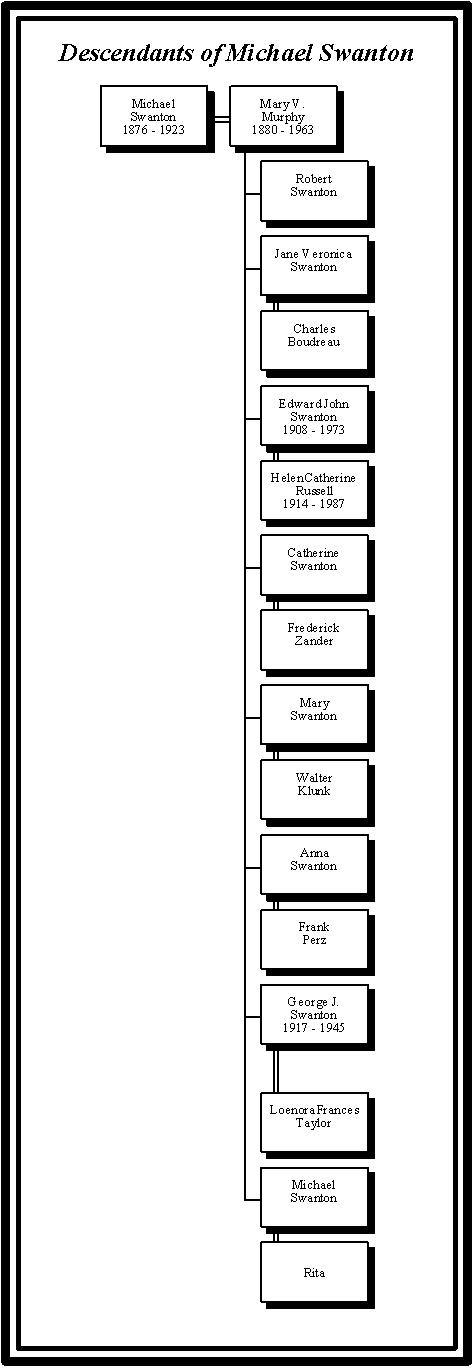
Michael
Swanton was born in Bandon,
They
had six children:
Robert,
Jane Veronica, Edward John (born 1908), Catherine, Mary, and Anna
Edward
T. Swanton, the grandson of Michael and Mary (Mamie) Swanton, sent me the
following information about his family. It provides a wonderful glimpse into
the lives of these people.
“I believe all of my
Grandparent's children were born and raised on NYC's Lower East Side in the
period of, say, between 1900 and the beginning of WWII. They all attended and
were either baptized or married, or both, at Saint Mary's RC Church on
I myself was born in
My Grandmother, whose name
was Mamie (Mary V. Murphy Swanton), was believed by all to have been a
"sainted" woman, who from the day her Mike passed away in 1923 until
the day of her death, attired herself only in black, except for her housecoat,
and prayed the Rosary every waking hour of her day, even when cooking or
talking to you. We all remember watching her lips move as she incessantly
fingered her beads, no matter what she was doing. And when we said,
"Gram, whom are you talking to", she'd say, "I'm saying a
decade for you". And you knew she was.
The saddest time in the family's
history that I remember was when in April 1945, the youngest brother, George,
only 28 years old and recently married, was killed in action on an island named
Of the eight sons and
daughters of Mike and Mamie Swanton, as well as their spouses, only one
survives as of this day, Aunt Anna, now 86 and living in
Aunt Anna passed away in 2001.
On
He was not a naturalized citizen of the
Children
of Michael and Mary Murphy Swanton







Children of Edward John Swanton and Helen Catherine Russell Swanton




Third Generation
Children of Michael Swanton and Elizabeth Bradfield
Johanna Swanton
Johanna Swanton, the daughter of Michael Swanton and Elizabeth Bradfield
Swanton, was baptized on
Third Generation
Children of Michael Swanton and Elizabeth Bradfield
Ellen T. Swanton and
Michael Cleary

Ellen T.[88]
Swanton was the third daughter of Michael and Elizabeth Bradfield Swanton. She
was baptized on

When Ellen was 14 years old, she lived in Boulteen at the
Boulteen Cross Roads, where her father did carpentry work and ran a pound. She
was confirmed in the Church of the Immaculate Conception in Enniskeane in 1868.
Ellen Swanton lived in
Sometime in 1882, Ellen immigrated to
Their brother, William, sailed to
There must have been a grand reunion among the Swantons
when Ellen and Martha arrived in
Once Ellen arrived in
Wherever she stayed, it was a fairly short-term
arrangement. On
Michael Cleary was the son of William Cleary and Margaret
(Peg) Barrett. Michael was baptized into the Catholic faith on

Ellen Swanton and
Michael Cleary in
Michael Cleary arrived in
Michael and Ellen Cleary’s first child was a daughter who
was born in July of 1885. They named her Margaret, after Michael’s mother.
Margaret’s grandmother, Bessie Bradfield Swanton, had died just a month before
Margaret Cleary was born. Margaret died at the age of 4 months, and was buried
with her grandmother at
A year later, on
In 1900, the Cleary family lived in
According to Claire Crowley, Ellen Swanton Cleary was the matriarch of the Swantons, and she “called the shots”, not only in her family, but also in Martha Swanton Crowley’s family. Ellen Swanton Cleary was very typical of the strong, tough, and sometimes unyielding Irish women of the times.

On
Elizabeth Cleary and Frank Lenihan were married in
Frank Lenihan died on
Mark Cleary married a woman named Hattie (Harriet), and
they had two daughters—Ella, who was born in 1914, and Francis, who was born in
1915. Mark, Hattie, Ella and Francis lived just around the corner from Ellen
and Michael Cleary, at
By 1920, all the children had moved out, leaving only
Michael and Ellen in the big house at
Michael Cleary died on
When Michael died, his daughter, Elizabeth A. Burns was
living at 116
In Michael Cleary’s will, he left all his real estate to
his wife, Ellen Swanton Cleary, for the duration of her life. He specified that
after Ellen’s death, the real estate was to go to his daughter, Elizabeth A.
Cleary Burns and her heirs.[96]
He left $1,000 each to his sons, John and William Cleary, $500 to Dorothy F.
Linehan, Elizabeth Cleary Burns’ daughter and $50 to the wife[97]
of his brother, William Cleary, in Cullane, Bally Landers,
There appear, however, to have been some bad feelings between Michael Cleary and his son Mark. Michael left $10 to Mark, essentially cutting him out of his will. Any money remaining after the legacies and costs of probating the will were to go to Elizabeth A. Cleary Burns.
Michael Cleary’s Will
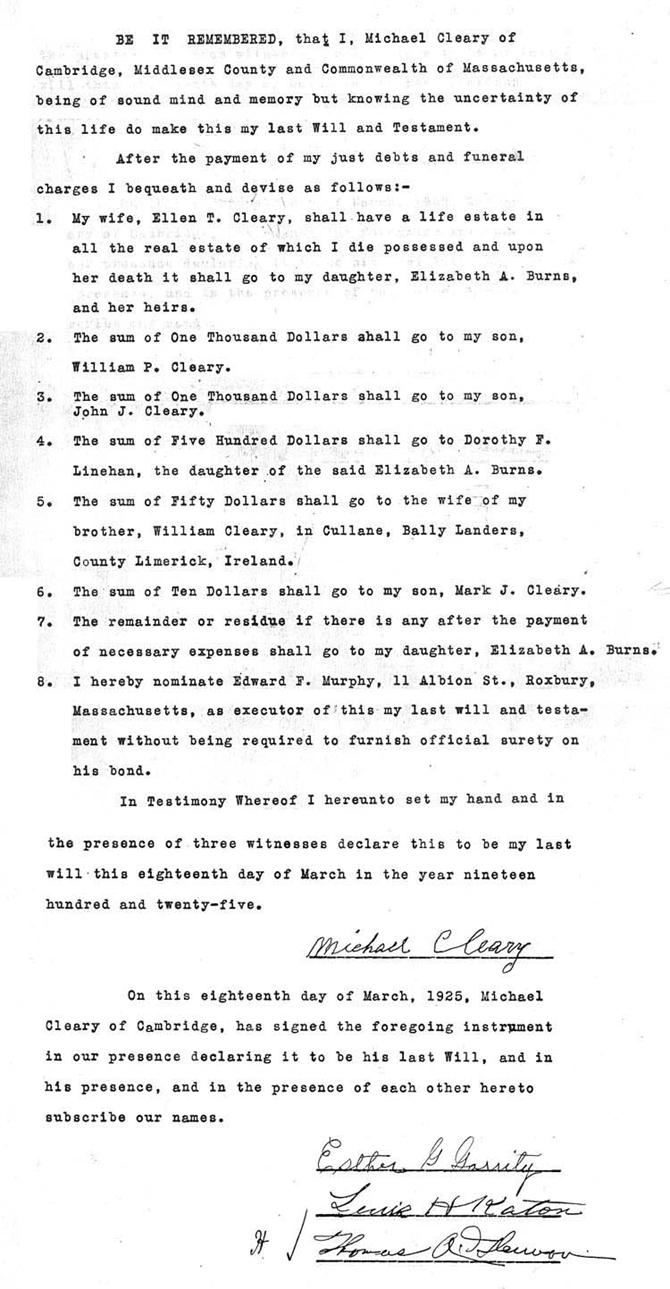
Ellen and Mark, contested Michael
Cleary’s will, filing an objection to it on
Ellen Swanton Cleary died on
Ellen had made a will in 1920 in which she divided her
possessions equally amongst her children. However, on
The terms of this new will were heavily biased in Mark’s
favor—in it,
Ellen Swanton Cleary’s Will
Signed Eight Days Before Her Death

When Ellen Swanton Cleary died, Elizabeth Cleary Burns
lived at
Mark Cleary had been named as the executor of Ellen’s will, but he declined, and Walter Costello was appointed in his place. The will was filed without probate, as it turned out there was no property real, personal or mixed, to pass under the will. When Walter filed Ellen’s will in the Probate Court, his petition contained some fairly unpleasant allegations.
He claimed that when Ellen Swanton Cleary died, she had been of advanced age (81), and for some period prior to her death she had been insane, suffering from violent mental disorders and general physical collapse. He claimed that she was unable to take proper care of herself and her possessions.
Walter Costello also claimed that while Ellen Swanton
Cleary was confined in
Mr. Costello went on to allege that when these joint accounts were created, Ellen was mentally incapacitated, and did not have the mental capacity to assent to the creation of these accounts. He also claimed that Ellen had retained sole control of the contents of the strong box during her lifetime.
He requested that Mark Cleary be ordered by law to turn over this money to the court, pending further investigation.
When these funds were frozen, Mark tried to access another joint bank account that he had opened in 1930. He claimed that it had been created for his benefit, and was not part of Ellen’s estate. He had deposited $1,000 into this account when he opened it, and it had accumulated interest since then.
After further investigation, Walter Costello filed his Findings of Facts, a carefully worded document outlining 25 points. These findings speak for themselves:
Middlesex, ss
Probate Court
#191215
Walter F. Costello Adm. Vs Mark J. Cleary et
als.
Mark J. Cleary vs Arthur Guy et als.
Requests for Findings of Facts by the
Complainant Walter F. Costello Adm.
1. That Ellen T. Cleary was unable to read, understand, or appreciate the contents of any documents during the period of her confinement at the Glenside Sanitarium.
2. That Ellen T. Cleary was in a confused state of mind on the day that she is alleged to have authorized the creation of the said joint accounts.
3. That the depositing of $14,000 in joint accounts was not a natural disposition by Ellen T. Cleary of such a sum.
4. That Ellen T. Cleary was aged, infirm and enfeebled and susceptible to undue influence.
5. That the disposition of the $14,000 in joint accounts rendered the estate of the Ellen T. Cleary insolvent.
6. That the opportunity to exercise undue influence over Ellen T. Cleary was peculiarly and exclusively afforded the respondent Mark J. Cleary.
7. That Mark J. Cleary did exercise undue influence over said Ellen T. Cleary.
8. That Mark J. Cleary was guilty of fraud in the manner in which he obtained the contents of the strong box.
9. That the admission of the respondent Mark J. Cleary to the effect that he wanted to divide the money equally with his sister is strong evidence that his title was illegally obtained.
10. That the previous will of Ellen T. Cleary in effect from A.D.1920 to A.D. 1929 leaving her property equally to all her children was the true intent of Ellen T. Cleary at the time of her death.
11. That said previous will was destroyed by or under the influence of the respondent Mark J. Cleary.
12. That the said Ellen T. Cleary had the same degree of affection and regard for all of her children.
13. That the creation of joint accounts and the drawing of a will within the same 24 hours are inconsistent and incompatible transactions.
14. That the alleged power of attorney, together with the alleged ratification of the respondent’s acts in writing and the drawing of the will, all at the instance of the respondent Mark J. Cleary is overwhelming evidence against the legality of the alleged transactions.
15. That Ellen T. Cleary retained full dominion and control of the money in the strong box up to the time of her death.
16. That the alleged creation of joint accounts by Ellen T. Cleary while in the hospital, even if legally created, was an attempted testamentary disposition and invalid because not made by will.
17. That after being told by Ellen T. Cleary that the strong box was not in its regular hiding place, the respondent Mark J. Cleary made a special trip to said hiding place and did search there for said strong box.
18. That Dr. Geo. A. Gaunt, an expert on neurology and psychiatry and mental diseases, did attend Ellen T. Cleary at or about the time of the alleged negotiations concerning the money in the strong box, and did testify that Ellen T. Cleary was unable to read or understand the contents of any papers even if read to her, and was unable to transact any business, and most of the time was incapable of knowing or recognizing things.
19. That the fact that the respondent Mark J. Cleary refused to take his sister to the hospital when he took his mother there is a suspicious circumstance.
20. That the fact that the respondent Mark J. Cleary was surprised at the amount discovered in the strong box indicates that the deceased, if she intended he should have it, did not disclose the amount to him even approximately.
21. That Mrs. Wilson, a witness to the will, testified that the deceased at the time of the execution of the will said “What are you all here for? What is all the hurry for?” and that in itself is evidence of undue influence.
22. That the various acts an incoherent talk of the deceased before her entry to the sanitarium were not those of a normal person.
23. That the desire of the deceased to have the Dorgan girls fix the money for her indicates that she did not desire the respondent Mark J. Cleary to do so.
24. That the fact that the respondent Mark J. Cleary admitted that when the deceased entered the hospital she did not tell him to get the money out of the strong box, but that he told her that he would get the money and put it in joint accounts does in itself indicate that she had no freedom of will in so disposing of the money.
25. That Mark J. Cleary wrongfully took the money in the strong box and then in an attempt to justify his actions, prepared the power of attorney, and also arranged for the execution of the will.
Following is Mark’s response to these findings:
Answer of Respondent
Mark J. Cleary
1. The respondent Mark J. Cleary admits that he filed the will of his mother, the late Ellen T. Cleary, in this Court, and in which he was named executor, and admits that he later filed a declination to act as executor of the will:
2. This respondent denies that his mother was 81 years of age at the time of her death; and denies that his mother was insane at the time of her death or at any time prior thereto, and calls upon petitioner to prove the same; and denies that his mother at any time suffered from violent mental disorders; and denies that his mother was unable to take proper care of herself or her possessions:
3. And this respondent denies that his mother had suffered a general physical collapse for any time more than the few days immediately preceding her death; and denies that the death of his mother was caused by mental disorders and calls upon petitioner to prove the same:
4. This respondent admits that shortly before her death his mother was confined to a private institution, but says that he has no knowledge that such confinement was for mental treatment and calls upon petitioner to prove the same; and, more specifically, this respondent denies that that his mother was ever at any time confined or committed to any institution of any kind for treatment with respect to her mental conditions.
5. This respondent admits that his mother had in her home a strong box and that said strong box contained a sum of money, but says that the amount was $14,000 and not $16,000 as averred by the petitioner; and admits that he went to his mother’s home while she was confined and searched for and found said strong box and broke open the same and took the contents and made deposit thereof in certain banks in joint accounts in his own name and the name of his mother, but denies that any of his acts were done without the full knowledge and permission of his mother or in any manner against her will.
6. And this respondent denies that his mother was mentally incapacitated at the time these joint accounts were created; and denies that his mother did not have the mental capacity to assent to the same; and denies that such deposits were made without the knowledge of his mother;
7. And this respondent denies that his mother had retained full control and dominion of the money in the strong box at all times in her life prior to her confinement to the hospital.
By his Attorneys
Kerwin & Boyle
W. M. Kerwin
A motion was made for the case to go to a jury trial, but
it doesn’t appear that a trial ever took place. The final account of Ellen Swanton
Cleary’s estate was filed on
This is the last document that appears in the probate file
for Ellen’s will. No mention was made of the disposition of the houses at
I don’t know if Mark was innocent or guilty, but I have to admit the evidence against him was pretty convincing. There’s a touch of irony, though, in that throughout this litigation, Mark was still working as a policeman on the Cambridge Police Force.
Mark Cleary died in 1952, and his wife, Hattie, died in
1974. They are buried with Mark’s parents, Ellen and Michael, and Mark’s
brother, George, in

Elizabeth Ann Burns died in April of 1971. She died of
heart failure in the
Descendants of Elizabeth Anne Cleary and
Frances Michael Lenihan
On
Dorothea and John Lenihan had three children:
John Downing Cooke II
Elizabeth Anne Cooke
Zelda Frances Cooke
John Downing Cooke III, provided the following personal sketch about his mother, Dorothea Frances Lenihan:
“My mother was an Irish Catholic girl born
and reared in the
She
left the church because my father refused to have anything to do with the
Catholic Church. In the spring of 1928, they moved to
Theirs
was a tumultuous relationship. So much so that my mother rarely spoke of
her family and at the time of her death, I knew nothing except that her father
was Frank or Francis. I also knew
my grandmothers maiden name was Cleary and a little of her family.”
Third Generation
Children of Michael Swanton and Elizabeth Bradfield
William Swanton and Anne
O’Neil

William Swanton,
the third son of Michael Swanton and Elizabeth Bradfield, was born in March of
1855 in the townland of Boulteen,
As more of the
Swanton family left
William immigrated
to the
On
As they became more
affluent, the Boston Irish gradually moved from
In 1889 and 1890,
William and Anne Swanton lived on
On
William was
successful in business; however, he seems to have had more than a few
shortcomings as a husband.
By 1900, William
and Annie had been married for 16 years, but had no children. William’s
siblings were very prolific, as were most of the Irish Catholic families of the
time, implying that there may have been some underlying medical reason for
their lack of children. Perhaps Annie’s
life would have turned out differently if she had had children.
On
I would imagine
this kind of thing wasn’t publicized or talked about much then, so filing for
separation support would have made this a very public incident, undoubtedly
causing a lot of embarassment for William.

On
On
Annie O’Neil
Swanton eventually withdrew her petition for separation support, although it
isn’t clear whether she moved back in with her husband.
On
It’s possible that
William had transmitted a venereal disease to Annie. One of the long-term side
effects of untreated syphilis is neurosyphilis, which is a slowly progressive
and destructive infection of the brain or spinal cord. This can result in
mental confusion, depression, uncoordinated movement, and dementia.
Also, in those day,
women were often committed for reasons that would seem trivial to us
today—melancholia, depression, unwanted pregnancies, or just because they were
inconvenient to their husbands. I can’t help but wonder what role Annie’s
sister, Bridget, played in all of this.
A letter written on

Annie remained at
Annie died on
When Anne died,
William filed an Administrator’s Bond to settle her estate. This bond indicated
that Anne’s last dwelling place had been
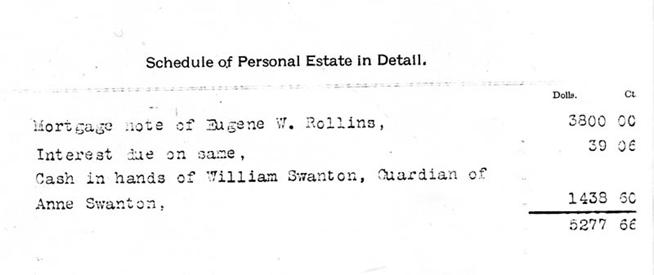
I contacted the
Annie O’Neill
Swanton is buried in
However, William’s father, Michael Swanton, died in the Bandon Workhouse in 1890, and until recently, I believed that he died a pauper and was buried in an unmarked grave. I discovered in 2001 that William had sent a sum of money to Father Murphy, the Enniskeane parish priest for the care of his father during his stay in the Bandon Workhouse. Unfortunately, the money arrived too late.
My great aunt, Mary
Margaret Swanton, remembers visits from her Uncle Will when she was young. He’d
give her a quarter, which at that time was a lot of money to a child. Claire
and Robert Crowley, the grandchildren of Martha Swanton Crowley (William’s
sister) remember Uncle Will doing the same for them. Auntie Mary also remembers
that he traveled back and forth from
Claire Crowley
remembers her Uncle Will telling his sister, Martha Swanton Crowley, not to
worry—that he would see that she was taken care of in his will. Unfortunately,
Martha died before William did, so it would have been a lot better if he had
helped her out while they were both still alive.
In 1920, William
Swanton lived alone in a triple-decker home, which he owned with no mortgage,
at
After Annie’s
death, William returned to

Seaview, Lislevane,
In 1998, I visited
Seaview and met Donal and Kathleen McCarthy, who had been neighbors of William
Swanton. Donal remembered seeing William once when he was a young boy. Donal
had cut through his yard, and William chased him off while brandishing a
stick!
Donal McCarthy
described Kate Bradfield as a very large woman. She would carry two buckets of
milk to the local co-op creamery, one on either side of her, and would take up
most of the road. She was also quite a flirt, and was convinced that all the
men in the village were after her.
William’s niece,
Mary Swanton Pinkham, remembers that her uncle used to travel between
William Swanton
died on

His next-of-kin in
American were aghast, as they had always counted on being William’s heirs,
based on a will William Swanton had written on
The will William
wrote in Ireland on the day he died (June 15, 1929) was contested by his heirs
in America, led by his nephews Leo D. Crowley (Martha and Michael’s son) and
Robert Swanton (Robert and Rosanna’s son).
Robert Swanton died
during the litigation from complications of appendicitis in 1931. After
Robert’s death, the Swantons felt that they weren’t being fairly represented in
this case by the
This case
eventually went to the High Court of Ireland. Leo Crowley and Kate Bradfield
eventually agreed that it was William’s intent that both the American will and
the Irish will were both to be in force at the time of his death and were to be
regarded as one instrument.
“It is agreed that
all assets and property of the deceased situated in the Irish Free State shall
be the property of Kate Bradfield and shall be administered by the Irish
Executrix (Kate), and that all the assets and property of the deceased situated
outside of the Irish Free State shall be the property of the persons named in
the American will and shall be administered by the American Executor (Leo)
named in said will subject as to the assets in American, in payment of the
monies hereinafter provided.”
The outcome of the
case was that Kate was allowed to keep the assets and property that William had
in

When William died,
he held the mortgages for the homes of Mary C. Flynn and Margaret E. Flynn on
William was buried
in the old
Kate remained at
Seaview in Lislevane until her death. She left the house to Richard Bradfield,
the father of Tommy Bradfield, currently of Enniskeane (died
Third Generation
Children of Michael Swanton and Elizabeth Bradfield
Martha Swanton and Michael Crowley

Martha Swanton
was the fourth daughter of Michael and Elizabeth Bradfield Swanton. She was
baptized on June 28, 1857 in the Church of the
Immaculate Conception in Enniskeane, County Cork , Ireland
In the 1900 Massachusetts Federal Census, it indicates
that Martha immigrated to the

On
Michael Crowley was the son of Michael and Mary Crowley.
Claire Crowley, Michael and Martha’s granddaughter, thought that Martha’s
brother, William Swanton, had helped Michael Crowley come to the
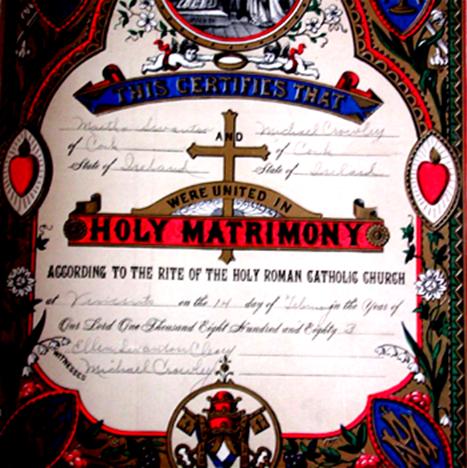
Martha and
Michael’s wedding record from the
Martha and Michael’s first child, Mary V. Crowley, was
born on
Their second child, Elizabeth, was born in 1886 and was
named after Martha’s mother, Bessie Bradfield, who had died in 1885. Elizabeth Crowley died on
Their first son, Michael Crowley, was born in October of
1887. Their third daughter, Martha Crowley, was born on
Michael and Martha’s fourth daughter, Katherine, known as
Kitty, was born in July of 1890. A second son arrived on
On
Michael was working as a house painter when he could find work. Martha stayed at home and took care of the house and the children. Their daughter, Mary, was now 16 and working as a stock-girl. Michael, Martha, Katherine were all at school, which they attended for nine months of the year, and little Willie, age 4, was home with his mother[102]. Willie died when he was young. Claire Crowley remembers being told when she was young that Willie had been “left out in the snow” and died. Child psychology wasn’t very advanced in those days!
Michael and Martha’s fifth son, Leo D. Crowley, was born
on
In 1920, the
Michael Crowley died between 1920 and 1927. In December of
1927, Martha and Michael Crowley lived at
On
Martha Swanton Crowley died just three days later, at the
age of 69, on Christmas day of 1927. The cause of death was cerebral
thrombosis, 2 weeks, and broncho pneumonia, 2 days. Leo Crowley was appointed
the administrator of Martha’s estate. Her estate was worth $1,808.84. After her
burial expenses of $432, the remainder was divided equally among
Third Generation
Children of Martha Swanton and Michael Crowley
Mary V. Crowley
Mary V. Crowley married
Third Generation
Children of Martha Swanton and Michael Crowley
Martha Crowley
In 1912, when she was 23, Martha Crowley became pregnant by a young man named Casey, who she later married. Her mother was scandalized by this out-of-wedlock pregnancy, and ejected Martha from the house. Claire Crowley remembers Martha as being a very sweet person. Martha, however, had a brain tumor, which impaired her behavior. She would be talking to someone and all of a sudden would start spinning around like a top.
In 1920, Martha Crowley’s daughter, Margie lived with her
grandparents, Michael and Martha Crowley at
Third Generation
Children of Martha Swanton and Michael Crowley
Michael Crowley
Michael Crowley Jr. joined the Navy. While he was
stationed in
Margaret Reilly was a widow when she married Michael Crowley, and she had two daughters from her first marriage: Mary Crowley (Hornung) and Josephine Crowley (Monahan). Mary is still living, but Josephine passed away in 1998.
On
At some point, Michael Crowley sent his wife and children
back to

Michael Crowley
and Margaret Reilly Crowley
Margaret's husband, Michael Crowley died in August
1934 of a strep infection. Margaret Reilly Crowley was buried on
Michael and Margaret Crowley were both
buried in Calvary Cemetary,
Third Generation
Children of Martha Swanton and Michael Crowley
Katherine Crowley
Kitty

Arthur Brousseau (with the spotted tie) and
the
Third Generation
Children of Martha Swanton and Michael Crowley
Robert Crowley
Robert Crowley married Helen Wittel and they lived at

Robert Crowley
and Helen Wittel Crowley, 1972
Helen ran a small neighborhood grocery store from her
house. On
Robert Crowley
worked for the Jordan Marsh department store all his life. His nickname was
Skull Crowley. Robert Crowley died in 1980 and his wife, Helen Wittel Crowley
died in 1992.

Robert Crowley retiring from Jordan Marsh
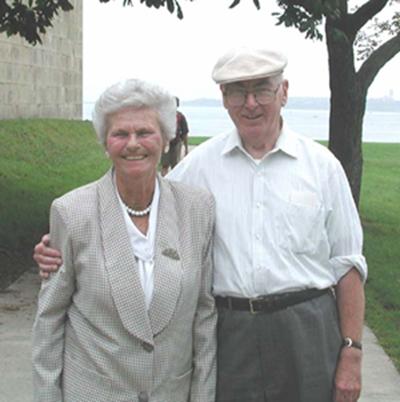
Claire Crowley and her brother, Robert
Crowley, August 2000
Claire Crowley married a Green and had a son named John, who became a doctor.
Robert Crowley is still living at the family home at 2
Story Street South Boston ,
and his sister, Claire, lives just a few houses down from him.
Third Generation
Children of Martha Swanton and Michael Crowley
Leo Crowley
Leo D. Crowley was born on November
17, 1900 . The
family was living at 90 E Street, South Boston , MA 180 Dorchester Street South Boston .
Leo, along with Robert Swanton,
headed up the litigation to contest William Swanton’s Irish will. Leo may have
married late in life.
Third
Generation
Children of Michael Swanton and Elizabeth Bradfield
George Swanton
George Swanton, the
son of Michael and Elizabeth Bradfield Swanton, was baptized on
Third
Generation
Children of Michael Swanton and Elizabeth Bradfield
James Swanton and Ellen
Ahearn

James Swanton, the
son of Michael and Elizabeth Bradfield Swanton, was baptized on
James was confirmed at the age of 14 in the parish of Desertserges in 1876 by Father Daniel Coveney. The family was living at Boulteen Cross Roads at the time, where his father was a carpenter and ran the local pound.

James
Swanton’s Confirmation Record
Four years later,
in 1880, James and his parents, along with his younger brother, Robert, left
When they arrived
in
On
Ellen’s parents
were William and Alice Corbett Ahearn, and they were from the parish of Kilbeheny
in


William Ahearn Alice Corbett Ahearn
James’ father,
Michael Swanton, returned to
James and Ellen
Ahearn Swanton continued to live at 274 W.
On
In February of
1892, they welcomed twin sons, who they named James and Robert. The twins were
baptized at

Johanna
Ahearn McNamara
James Swanton was working
as a day laborer, and it couldn’t have been an easy task for him to support his
rapidly-growing family. Ellen had her hands full, too, taking care of four
young children under the age of five.
The summer heat in their small rooms must have been unbearable, and in the evenings, many people would sit outside to try and catch a passing breeze and gossip with their neighbors. With so many people living in such close quarters, I can’t imagine that many secrets were successfully kept!
Epidemics spread
like wildfire through this congested community, and child mortality was very
high. There were no vaccinations available for most diseases. On
Cholera is caused by a water-borne bacteria, and generally occurs during the summer months in areas where the sanitation is poor. The diarrhea and vomiting brought on by the infection quickly leave the body without enough fluid. The resulting dehydration and shock could kill a person within hours.
Little Robert Swanton was just five months old when he came down with cholera, and within four days, he was dead. Ellen and James must have been heartbroken to lose their baby son, but thankful that their three other children had been spared.
In November of
1895, Ellen and James’
first daughter was born, and they named her
Just 10 months
later, their fifth son, George, was born in October of 1896. On
At the beginning of
December 1900, Ellen Ahearn Swanton was more than eight months pregnant with
her eighth child. Winters in
On
Diptheria is an infection of the throat caused by a bacterium that produces a protein called diphtheria toxin. This protein causes the cells in the throat to die by stopping the production of protein. Diphtheria is highly contagious, and is passed from person to person by droplet transmission, and can be caught by breathing in the diphtheria bacteria after an infected person has coughed, sneezed or even laughed. The toxin can get into the bloodstream and cause heart damage, which is the most common cause of death in diphtheria patients.
It would have been difficult to
isolate George and Elizabeth to try to prevent the disease from spreading, and
Ellen may have sent the other children off to stay with a neighbor. George and
Elizabeth were having trouble breathing, and Ellen would have sent for the priest
to administer the last rites. George Swanton died on
It’s hard to imagine how a family could deal with such terrible loss. But the Irish Catholics’ faith was strong, and they believed that these things happened because they were God’s will, and it was His way of testing their faith. However, this must have been a very difficult time for the family to go through. It would have been no consolation for them to realize that the same thing was happening all around them to their neighbors and their children.
Twelve days later, Ellen and James’ eighth and last child was born. It was a boy, and they named him Patrick Francis Swanton.
By

Ellen
Ahearn Swanton
In June of 1900,
the family was again living at
Ellen was now a widow with four children to take care of. Her son Michael was 13, William was 11, John was 3, and Patrick was 1.
In 1905, Ellen and
her children moved to
From 1910 to 1925,
Ellen lived at
On

John Swanton and Mildred Killeen Wildes Swanton
Ellen lived to be 69, and welcomed the arrival of fourteen grandchildren. Her young granddaughters must have reminded her of her own young daughter, Elizabeth, whom she had loved so much and lost so soon.

Ellen
Ahearn Swanton with her granddaughters
Katherine (baby), Peggy and Ellen Swanton
Daughters of Patrick Swanton and Margaret Mary Mogan
Ellen Ahearn
Swanton died on
Fourth Generation
Children of James Swanton and Ellen Ahearn
Michael J. Swanton and Mary A. McCauley
Michael
J. Swanton, the first son of James and Ellen Ahearn Swanton, was born on February 4, 1888 in South
Boston , Massachusetts

Michael
J. Swanton
Michael Swanton was
thirteen years old when his father died of pleuro-pneumonia on
On
Their first child,
a daughter, was born on
A daughter of
Michael and Mary’s named Josephine died on
Josephine died in
the
Their third
daughter, Mary Jane Swanton, was born on
Between 1910 and 1920, Michael Swanton worked as a piano finisher[106]
Their fifth daughter, Gertrude E. Swanton, was born in 1914. I was not able to find a birth record for Gertrude, and calculated her year of birth from her marriage record.
Their six daughter, Alice Josephine Swanton, was born on
On
Mary McCauley Swanton’s mother, Jane Hussie McCauley, lived with the Swanton family in 1920. She was 60 years old and a widow.
Michael and Mary’s
seventh daughter, Agnes Rita Swanton, was born on
On

Michael
J. Swanton, Mary A. McCauley Swanton
and their only son, Jimmie Swanton
On
On
On
Agnes Rita Swanton married in 1942.
On
On
From 1934 to 1950,
the Swanton family lived at

The City of
Boston established the Boston Sanatorium, first known as Consumptives Hospital,
for the care of indigent persons suffering from advanced tuberculosis, one of
six hospitals created in the first decade of the 20th century to provide
additional services for the city’s poor. The 51-acre campus along the
Michael J. Swanton
died on
Michael and Mary
McCauley Swanton were living at
Fourth Generation
Descendants of James Swanton and Ellen Ahearn
William J. Swanton and Elizabeth V. Gaffney
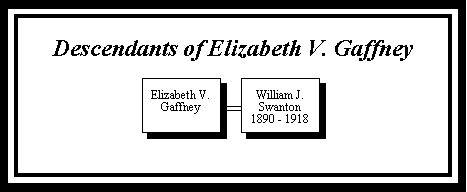
William J. Swanton,
the second oldest son of James and Ellen Ahearn Swanton, was born in January of
1890 in
On
John W. McCormack, the future Speaker of the House of Representatives, remembers this epidemic:
“We used to call it galloping pneumonia. You
couldn’t walk down any street in
Older residents can still remember scenes of
the horse-drawn wagon moving slowly along the street, stopping before the
houses to take out the bodies of those who had died during the night. One local
doctor complained that he could not walk down any street in the district
without people rushing out, clutching wildly at his clothing, trying to drag
him into their homes to tend to the sick members of their family.[108]
On
Fourth Generation
Descendants of James Swanton and Ellen Ahearn
John R. Swanton and Mildred K. Wildes

John Robert Swanton
was born in July of 1898 in
In 1923, when John was 25, he married Mildred Wildes, the 21-year-old daughter of Charles and Delia Killeen Wildes.

John
Robert Swanton and Mildred Wildes Swanton
John and Mildred
Swanton lived at
John and Mildred’s
first son, William Joseph Swanton, was born on
On
John and Mildred
Swanton’s last child, Kenneth Gerard, was born on

John Robert Swanton
died at the age of 62 in November of 1960. He was buried on
John and Mildred’s
daughter, Betty, married Stephen D. Temple on
Billy Swanton
married Jerane Anne Sartori, and, their first child, Jerane Ann Swanton, was
born in 1953. The family was living at
Fourth Generation
Descendants of James Swanton and Ellen Ahearn
Patrick Francis Swanton and Margaret Mary Mogan
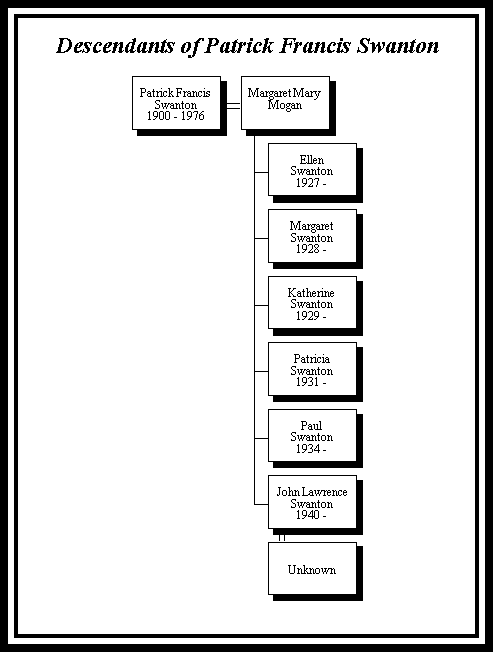
Patrick Francis Swanton was born on

Patrick Francis Swanton
In 1920, Patrick lived as a boarder at his mother’s house on 212
W. Ninth Street South Boston .
He was a student at the time. In 1925, he was still living there, but was
working as a printer.
On
On

Ellen Marie Swanton
On

Ellen
and Peggy Swanton
Patrick and Margaret’s third daughter,
Catherine Anne Swanton, was born on

Patrick Francis Swanton, Margaret Mary Mogan Swanton,
and Catherine, Paul and Patricia Swanton
Patrick and Margaret’s last child, John Lawrence
Swanton, was born on
Patrick Francis Swanton died in May of 1976 in
Hi son, John Lawrence Swanton, married and had four
sons: John Lawrence II, Patrick Louis, Michael Lennon, and Matthew Lee Swanton.
John Lawrence Swanton II and his wife Deborah have
two sons: Zachary and Elijah. Patrick has no children, and Matthew is currently
a senior in high school.
Michael Lennon Swanton married Imogene Bradfield of

John Lawrence Swanton and his granddaughter, Julia Meghan
Swanton
Second
Generation
Children of Michael Swanton and Elizabeth Bradfield
Robert A. Swanton and
Rosanna Agnes Hanlon

Robert A. Swanton was born on
Robert A. Swanton was my great-grandfather.

Robert
A. Swanton
Robert A. Swanton
was baptized on

Baptismal
Record of Robert Swanton, son of Michael Swanton and Elizabeth Bradfield
Swanton
Robert was
confirmed in the parish of Desertserges in 1876 when he was 11 years old. Four
years later, when Robert was 15, he traveled to
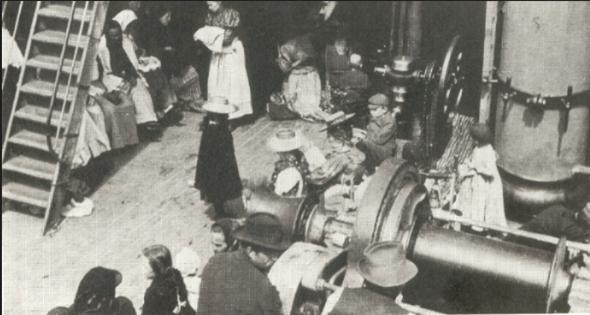
Steerage
Passengers at Sea, around 1902
Michael, Bessie, Robert and James arrived in
They moved in with Michael and Bessie’s oldest son, John,
his wife, Mary, and their five children at 306 West Second Street in
From 1886 to 1888, Robert lived with his brother, William,
at
Robert Swanton became a naturalized citizen of the
On

On
Robert and Rosanna’s third son, Robert
Swanton, was born on

Robert Swanton, son of William Anthony
Swanton
In 1903, Robert and Rosanna’s oldest son, George, died. He
was buried in
Robert and Rosanna’s second daughter, Mary Margaret Swanton,
was born on

Mary Margaret
Swanton

Mary Margaret Swanton

Mary Margaret Swanton Pinkham and William Swanton

Mary Margaret Swanton
Pinkham at 92
Robert and Rosanna’s last child, Elizabeth Camille Swanton,
was born on

Theresa McCluskey, Rosanna Hanlon Swanton, Margaret Mary Swanton, Elizabeth Camille Swanton, Rosalind Geerer, John McCluskey, Kenneth Geerer

WILLIAM
ANTHONY SWANTON (my
grandfather) married Marion L. Cross on
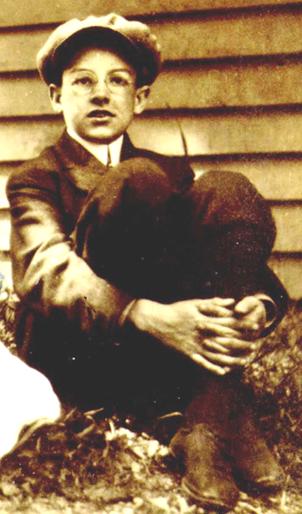
William
Anthony Swanton as a young boy
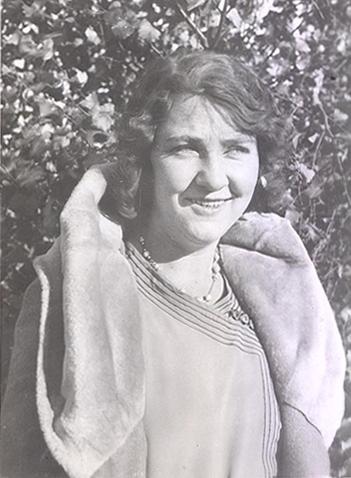
Marion
Cross Swanton

William Anthony Swanton and Marion Louise
Cross Swanton
William and Marion had three children:
William
Bernard Swanton, born 1921 My father
Eleanore Swanton, born 1925
Robert
Henry Swanton, 1928, died

Marion Daly, Marion Cross, Tommy Daly,
Bobby Swanton, Eleanore Swanton, Billy Swanton

William and Marion Cross Swanton
and their children, Billy, Bobby and Eleanore

William
Bernard Swanton and his parents,
William Anthony Swanton and Marion Louise Cross Swanton
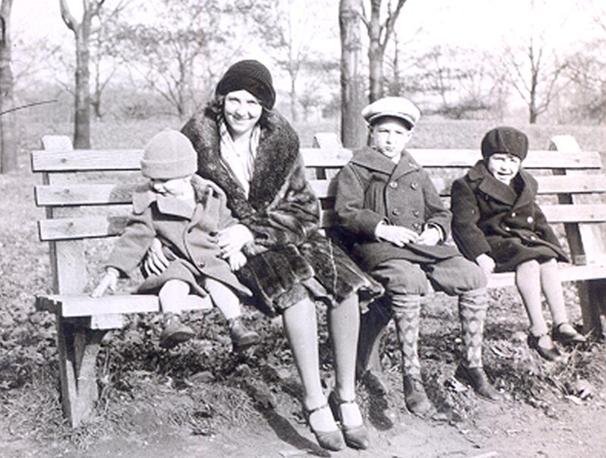
Bobby Swanton, Marion Cross Swanton, Billy Swanton, and
Eleanore Swanton

Eleanore Swanton, Marion Cross Swanton and
Rosanna Hanlon Swanton (Grandma Swanton)
Marion
Cross Swanton died on
William Anthony Swanton remarried on
William Swanton was a heavy smoker, and he died in June of
1986 in
FIFTH GENERATION
William Bernard Swanton and Nadine Wanda Mary Haller

William
Bernard Swanton, the oldest
child of William Anthony Swanton and Marion Cross Swanton, was born on
Dad remembers going over to
William Swanton married Nadine Wanda Mary
Haller on

Billy Swanton at 9 months

William Bernard Swanton in the Air Force

Nadine Wanda Mary
Haller at 14

Nadine Wanda Mary
Haller

Nadine Wanda Haller on her wedding day
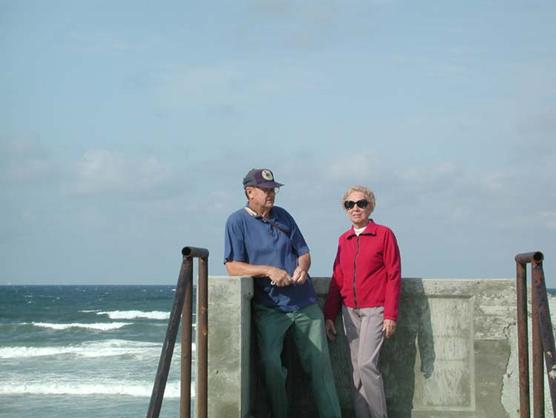
Bill and Nadiine Swanton at
Bill and Nadine’s children are:
Eileen Marie Swanton
Carol Ann Swanton
Virginia (Ginni) Louise Swanton
James Thomas Swanton
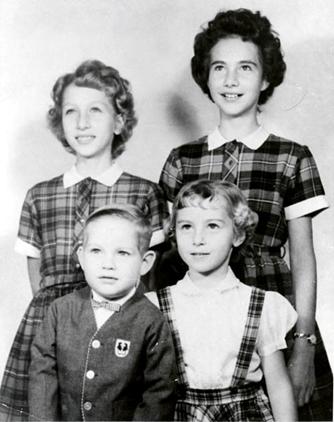
Eileen,
Carol, Ginni and James Swanton
SIXTH GENERATION
Descendants of William and Nadine Swanton
Eileen Marie Swanton, the
oldest child of William and Nadine Swanton, marrried
Leland Smith on June 12, 1971 at St. Theresa’s Church in West Roxbury. They
were divorced on
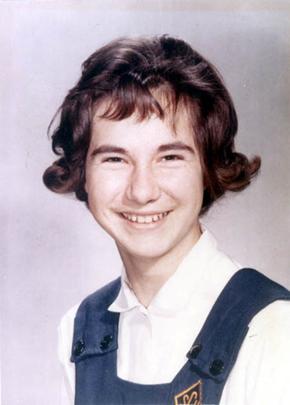
Eileen Swanton’s High School Picture
Carol Ann Swanton remained single, and dotes on her 11 month old, 90 pound “puppy”,
Kodiak. Carol works in the software industry and was on the Ski Patrol for many
years.

Carol Swanton helehiking at Denali, Alaska

Virginia (Ginni) Louise Swanton married David Arthur Ruckert on
Ginni worked at Microsoft for 9 years, and
at a small software company where she wrote their software manuals, online help
systems, and spearheaded their marketing and PR efforts. She is currently a
professional race car driver in the Star Formula Mazda television series. She
also enjoys the outdoors, especially hiking with her two dogs,Shelby and Kirby. Ginni has also spent countless
hours tracing and documenting her family tree. This book is the result of her
research.

Ginni Swanton
on top of Camelback Mountain in Arizona

Ginni enjoying an evening out with friends

Eileen, Carol and
Ginni Swanton
There’s
an interesting story behind this photo. Eileen and Carol wore matching pink
dresses with mink collars, while I was wearing a babyish little yellow dress
with ruffles. I wanted a pink dress with a mink collar, too. Consequently I was
an absolute pill during the photo session, crying and throwing a tantrum. The
photographer was ready to pack up his equipment, but my mother asked him to try
just one more time. For some unknown reason, I cooperatively hopped up on the
piano bench, giving the camera an angelic smile.
Stacie Lyn Ruckert, born
Stacie is currently a senior at
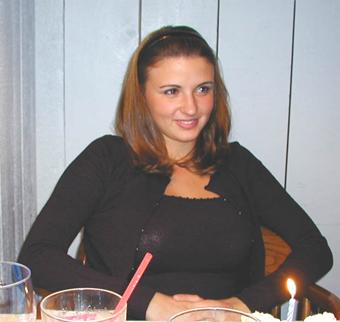
Stacie
Lyn Ruckert

Stacie Lyn Ruckert
James Thomas Swanton
SIXTH GENERATION
Descendants of Eleanore Swanton and Eugene
Francis Peyton

ELEANORE SWANTON
(Auntie Eleanore/Aunt Ellie) married Eugene Francis Peyton before 1950. Eugene
(Uncle Genie) was a schoolteacher. He died on
Garrett John Peyton
Ellen Louise Peyton
Lauren Marie Peyton
Gene William Peyton
SIXTH GENERATION
Descendants of Eleanore and Robert Swanton

Garrett John Peyton married Julie Lange in 1977, and will be celebrating their 25th
anniversary in 2002. Julie was born in
Brooke Peyton
Wesley Peyton 1986 (Seventh Generation) Wesley is in the
eighth grade at a private school.

Ellen Louise Peyton married Francis McDavitt in
Christine
McDavitt born
Kate
McDavitt born
Jennifer
McDavitt born
Jennifer and Kate are both going to Harvard,and Christine is a field
hockey coach for

Lauren Marie Peyton married Darren Zysk in
Hillary
Zysk born
Tacy
Zysk born
Kendra
Hilary Zysk born
Gene William Peyton remained single, but lives with a lovely woman named Susan, and works
as a chef in
FIFTH GENERATION
Robert Henry Swanton and Elizabeth Logie

ROBERT
HENRY SWANTON married
Elizabeth Loggie, the daughter of Rose Connington and Ira Loggie, of
Robert Edward Swanton, born
Mary Elizabeth Swanton, born
Anne Marie Swanton, born
William
Anthony Swanton, born
Kathleen Rose Swanton, born
Elaine Marion Swanton, born
Karen Marie Swanton, born

Eleanore, Billy and Bobby Swanton

Auntie Betty at her daughter Elaine’s
wedding

Uncle
Bobby, Auntie Eleanor and Dad
SIXTH GENERATION
Descendants of Robert Henry and Elizabeth (Aunty Betty) Swanton

Mary Elizabeth Swanton married Keith Leslie Ackley. They had two
children
Elizabeth
Ackley born 1989 (7th
generation)
James Colson Ackley born 1991 (Colson is a name from the Ackley
family) (7th generation)

Mary Beth Swanton Ackley at her sister Elaine’s Wedding

Elaine Swanton and Groom, Bill, at her wedding

Anne Marie Swanton married Timothy Gillis. Thave two children:
Cameron
John Gillis, born 1996 (7th generation)
Sean
Timothy Gillis, born 1998 (7th generation)
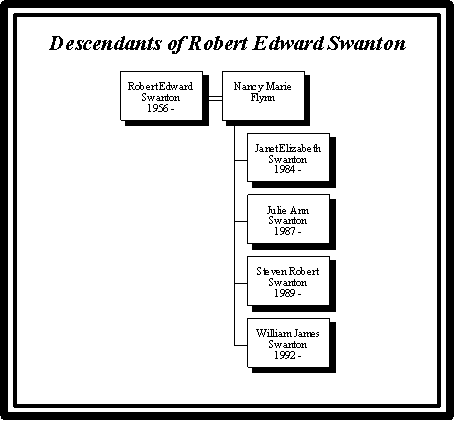
Robert EDWARD Swanton married Nancy Marie Flynn. They had 4
children.
Janet
Elizabeth Swanton, born 1984 (7th generation)
Julie
Ann Swanton, born 1987 (7th generation)
Steven
Robert Swanton, born 1989 (7th generation)
William
James Swanton, born 1992 (7th generation)

William Anthony Swanton married Debbie
Flannery. They were later divorced, and Billy married Lori Barrett. Billy is
carrying on the family tradition, and is a carpenter. Billy and Lori have one
child:
Shane
William Swanton, born 2000 (7th generation)
Kathleen Louise Swanton
Elaine Marion Swanton
Karen Marie Swanton

Karen Swanton at her sister Elaine’s wedding

